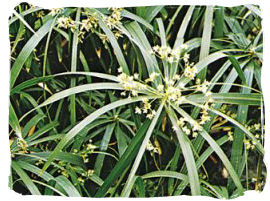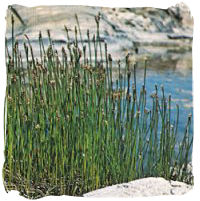The Planet
Flora and Fauna
Some two-million-plus years ago, a planet was transported to its current orbital path following that of Earth's and provided the native Priest-Kings with an accessible world to stock their planet with more interesting species to fill their vivaria.
Many of the plants found on Gor are unknown to Earth; perhaps some originating on Earth, but adapting to the strange, new gravity of Gor, and the harshness of the world itself. I've seen an "official" site (or I should say, once official) describe the plant and animal life as near-prehistoric, especially on the fact of carnivorous plantlife on Gor (the leech plant). Read more on this topic under Leech Planet below.
Many of the following plant-life either bears an edible seed or fruit, or the plant itself is edible, or the plant in whole or part can be used for medicinal purposes. While I go into some detail as far as the plant itself, for details on eating, drinking or healing properties, please refer to the appropriate page(s).
Apricot Tree
Tree which produces a small orange edible fruit with a single pit.  The apricot is mentioned only once in all the books.
The apricot is mentioned only once in all the books.
"I brushed away two sellers of apricots and spices." — Tribesmen of Gor, page 45.
Bazi
An herb used to brew an herbal beverage important to both the Innuit of the arctic region, as well as those of the desert, the Tahari. Though it is not stated that this herb is grown in the warmer climates, as is the case with most herbs, due to its name (Bazi) speaks of the jungle regions. It is a good that is likely exported to the regions in the north, perhaps purchased at the Fairs in goodly quantities. The fact that "southern sugars" are also mentioned, would support this.
"Hot Bazi tea I wanted. This is an important trade item in the north. I now knew why. The southern sugars are also popular. I had originally supposed this was because of their sweetness, there being few sweet items, save some berries, in the north. I now began to suspect that the calories of the sugars also played their role in their popularity. The red hunters think little of eating half a pound of sugar at a sitting." — Beasts of Gor, page 207.
"In turn, from the oases the nomads receive, most importantly, Sa-Tarna grain and the Bazi tea… Tea is extremely important to the nomads. It is served hot and heavily sugared. It gives them strength then, in virtue of the sugar, and cools them, by making them sweat, as well as stimulating them. It is drunk three small cups at a time, carefully measured." — Tribesmen of Gor, pages 37-38.
Beans
Legumes of many varieties; besides being good for a person to eat, they offer many healing properties. 
"A great amount of farming, or perhaps one should speak of gardening, is done at the oasis, but little of this is exported. At the oasis will be grown a hybrid, brownish Sa-Tarna, adapted to the heat of the desert; most Sa-Tarna is yellow; and beans, berries, onions, tuber suls, various sorts of melons, a foliated leaf vegetable, called Katch, and various root vegetables, such as turnips, carrots, radishes, of the sphere and cylinder varieties, and korts, a large, brownish-skinned, thick-skinned, sphere-shaped vegetable, usually some six inches in width, the interior of which is yellowish, fibrous and heavily seeded. At the oasis, because of the warm climate, the farmers can grow two or more crops a year." — Tribesmen of Gor, page 37.
"I saw too, fields, fenced with rocks, in the sloping area. In them were growing, small at this season, shafts of Sa-Tarna; too, there would be peas, and beans, cabbages and onions, and patches of the golden sul, capable of surviving at this latitude." — Marauders of Gor, page 81.
"At the oasis, will be grown a hybrid, brownish Sa-Tarna, adapted to the heat of the desert; most Sa-Tarna is yellow; and beans…" — Tribesmen of Gor, page 37.
Berry Shrubs
Shrubbery producing unspecified types of berries.
"…and small, dry berries gathered from the nearby shrubbery were our only sustenance." — Tarnsman of Gor, page 115.
"A great amount of farming, or perhaps one should speak of gardening, is done at the oasis, but little of this is exported. At the oasis will be grown a hybrid, brownish Sa-Tarna, adapted to the heat of the desert; most Sa-Tarna is yellow; and beans, berries, onions, tuber suls, various sorts of melons, a foliated leaf vegetable, called Katch, and various root vegetables, such as turnips, carrots, radishes, of the sphere and cylinder varieties, and korts, a large, brownish-skinned, thick-skinned, sphere-shaped vegetable, usually some six inches in width, the interior of which is yellowish, fibrous and heavily seeded. At the oasis, because of the warm climate, the farmers can grow two or more crops a year." — Tribesmen of Gor, page 37.
Black Wine Tree
These are the coffee trees of Earth. The beans were long ago introduced on Gor and the black wine bean is grown only on the slopes of Thentis, thus rendering this an extremely expensive luxury. 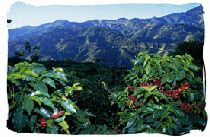 Pictured is an arabica tree, which is a popular coffee on Earth.
Pictured is an arabica tree, which is a popular coffee on Earth.
"Black wine," said she, "from the Mountains of Thentis." I had heard of black wine, but had never had any. It is drunk in Thentis, but I had never heard of it being much drunk in any of the other cities.
"I have heard," I said to Elizabeth, "that black wine is served hot." In short order two bowls, steam cuffing out of them, were brought and placed on the table. I sat there staring down at them, and Elizabeth did, too. Then I picked up one of the thick, heavy clay bowls. Since no one was looking, we knocked the bowls together and put them to our lips. It was extremely strong, and bitter, but it was hot, and, unmistakably, it was coffee. …
"Actually," I said to Elizabeth, "this is very rare. Thentis does not trade the beans for black wine. I have heard of a cup of black wine in Ar, some years ago, selling for a silver eighty-piece. Even in Thentis black wine is used commonly only in High Caste homes."
"Perhaps it is from Earth?" she asked.
"Originally, doubtless beans were brought from Earth," I said, "much as certain other seeds, and silk worms and such, but I doubt very much that the ship I saw last night had in its cargo anything as trivial as the beans for black wine." — Assassin of Gor, pages 106-107.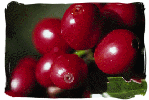
"… the unmistakable odor of coffee, or as the Goreans express it, black wine. The beans grow largely on the slopes of the Thentis mountains… black wine is far more common on Earth than on Gor, where it is, except for the city of Thentis, a city famed for her tarn flocks, and her surrounding villages, a somewhat rare and unusual luxury… I, grasping the pot with a rag and both hands, poured him a handled, metal tankard of the steaming black brew, coffee or black wine." — Slave Girl of Gor, pages 73-74.
"I grinned, and washed down the eggs with a swig of hot black wine, prepared from the beans grown upon the slopes of the Thentis mountains. This black wine is quite expensive. Men have been slain on Gor for attempting to smuggle the beans out of the Thentian territories." — Beasts of Gor, page 21.
"On the tray, too, was the metal vessel which had contained the black wine, steaming and bitter, from far Thentis, famed for its tarn flocks, the small yellow-enameled cups from which we had drunk the black wine, its spoons and sugars…" — Explorers of Gor, page 10.
Brak Brush A shrub whose leaves have a purgative effect when chewed; likely then is used in healing. Traditionally, branches of brak are nailed to house doors during the Waiting Hand to discourage the entry of bad luck into the house for the New Year.
"On the first day of the Waiting Hand, the last five days of the old year, the portals of Ar, including even that of the House of Cernus, had been painted white, and in many of the low-caste homes had been sealed with pitch, not to be opened until the first day of En'Kara. Almost all doors, including that of the House of Cernus, had nailed to them some branches of the Brak Bush, the leaves of which, when chewed, have a purgative effect. It is thought that the pitch and the branches of the Brak Bush discourage the entry of bad luck into the houses of the citizens." — Assassin of Gor, pages 211-212.
Cabbage
Round, green leaf vegetable. 
"I saw too, fields, fenced with rocks, in the sloping area. In them were growing, small at this season, shafts of Sa-Tarna; too, there would be peas, and beans, cabbages and onions, and patches of the golden sul, capable of surviving at this latitude." — Marauders of Gor, page 81.
Cacao Tree
Tree no doubt brought from earth, grown in the tropics and obtained by the merchants of Cos. 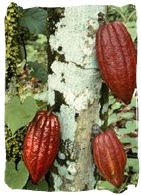 Pictured at left, unripened cacao nuts.
Pictured at left, unripened cacao nuts.
"This is warmed chocolate," I said, pleased. It was very rich and creamy.
"Yes, Mistress," said the girl.
"It is very good," I said.
"Thank you, Mistress," she said.
"Is it from Earth?" I asked.
"Not directly," she said. "Many things here, of course, ultimately have an Earth origin. It is not improbable that the beans from which the first cacao trees on this world were grown were brought from Earth."
"Do the trees grow near here?" I asked.
"No, Mistress," she said. "We obtain the beans, from which the chocolate is made, from Cosian merchants, who, in turn, obtain them in the tropics." — Kajira of Gor, page 61.
 |
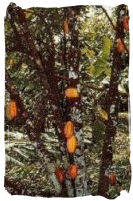 |
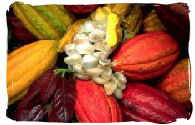 |
Carpet Plant A plant of the rainforest area inland of Schendi having leaves that are sometimes used as a source of drinking water. The leaves, large and fibrous, can also be used for things such as bandaging. On Earth, carpet plants are available in many varieties, such as, Riccia, Java Moss, Willow Moss, Microsword, and one of the most popular, Glossostigma. They are called such because of the way they grow, creating a "carpet" of greenery.
"I then rose to my feet and walked a few yards away, to a fan palm. From the base of one of its broad leaves I gathered a double handful of fresh water. I retuned to the girl and, carefully, washed out the wound. She winced. I then cut some leaves and wrapped them about it. I tied shut some leaves and wrapped them about it. I tied shut this simple bandage with the tendrils of a carpet plant." — Explorers of Gor, page 347.
Carrot
A root vegetable; the staple of Bugs Bunny. 
"A great amount of farming, or perhaps one should speak of gardening, is done at the oasis, but little of this is exported. At the oasis will be grown a hybrid, brownish Sa-Tarna, adapted to the heat of the desert; most Sa-Tarna is yellow; and beans, berries, onions, tuber suls, various sorts of melons, a foliated leaf vegetable, called Katch, and various root vegetables, such as turnips, carrots, radishes, of the sphere and cylinder varieties, and korts, a large, brownish-skinned, thick-skinned, sphere-shaped vegetable, usually some six inches in width, the interior of which is yellowish, fibrous and heavily seeded. At the oasis, because of the warm climate, the farmers can grow two or more crops a year." — Tribesmen of Gor, page 37.
Celane Melons
This is another example of the rampant misinformation that plagues many Gorean sites. There is no such melon on Earth or on Gor. There are, however, unspecified varieties of melons mentioned in the books. Please refer to "Melons" on this page. Celane is a purgative bush found on Earth; refer to the Onlinisms page.
Cherries
Delicate tree which bears tiny delicious red fruit grown in the city of Tyros.  Besides being a delicious fruit to eat, cherries are known for their healing properties. See also: Chokecherry.
Besides being a delicious fruit to eat, cherries are known for their healing properties. See also: Chokecherry.
"It reminds me of the cherries of Tyros," I said. — Beasts of Gor, page 349.
Chokecherry
A variety of cherry found on the Barrens. See also: "Cherry."
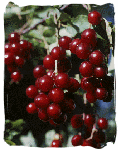 The chokecherry, also known as the black cherry, is native to Idaho, Montana, et al, and once widely used as a food by Native Americans. Chokecherries have long been favored for jellies, syrups, sauces, jams and wine in the prairie states. The leaves, seeds and stems are poisonous, but the fruit, which ranges from crimson to red to yellow to white, depending on the cultivar, is tasty. Chokecherries have greater healing properties than their lighter-meated cousins.
The chokecherry, also known as the black cherry, is native to Idaho, Montana, et al, and once widely used as a food by Native Americans. Chokecherries have long been favored for jellies, syrups, sauces, jams and wine in the prairie states. The leaves, seeds and stems are poisonous, but the fruit, which ranges from crimson to red to yellow to white, depending on the cultivar, is tasty. Chokecherries have greater healing properties than their lighter-meated cousins.
Etymology: so called from the bitter taste;
"1a: A common cherry (Prunus virginiana) of eastern No. America;
1b: A cherry (P. demissa) of the western United States;
1c: Black Cherry;
2: The astringent fruit of any chokecherry." — Merriam-Webster Dictionary ©2004-2006.
"I lifted the crumbled pemmican to my mouth and ate of it. There are various ways in which pemmican can be prepared, depending primarily on what one adds into the mixture, in the way of herbs, seasonings and fruit. A common way of preparing it is as follows. Strips of kailiauk meat, thinly sliced and dried on poles in the sun, are pounded fine, almost to a powder. Crushed fruit, usually chokecherries, is then added to the meat. The whole, then, is mixed with, and fixed by, kailiauk fat, subsequently, usually, being divided into small, flattish, rounded cakes. The fruit sugars make this, in its way, a quick-energy food, while the meat, of course, supplies valuable, long-lasting stamina protein." — Blood Brothers of Gor, page 46.
Cinnamon
A tree which produces a fruit, generally ground into a sweet spice which is a main export of the Schendi region; 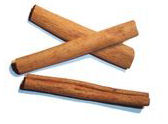 also has medicinal value.
also has medicinal value.
Etymology: Middle English cynamone, cynamum, from Middle French & Latin; Middle French cinnamome, from Latin cinnamomum, cinnamon, cinnamum, from Greek kinnamomon, kinnamon, of non-Indo-European origin; akin to Hebrew qinnamon cinnamon;
"1a : The highly aromatic bark of any of several trees of the genus Cinnamomum yielding cinnamaldehyde and other aromatic products in the form of cinnamon oil;
1b: A culinary spice prepared from cinnamon either by powdering or by drying in small rolls;
2: A tree that yields cinnamon." — Merriam-Webster Dictionary ©2004-2006.
"Yes," I said. "It is cinnamon and cloves, is it not?"
"Yes," said Ulafi, "and other spices, as well." — Explorers of Gor, page 98.
Clover
Low growing, three-leafed plant; being as there are no leprechauns on the four-leaf variety is nothing of importance. 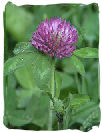
Etymology: Middle English; Date: before 12th century;
"Any of a genus (Trifolium) of low leguminous herbs having trifoliolate leaves and flowers in dense heads and including many that are valuable for forage and attractive to bees." — Merriam-Webster Dictionary ©2004-2006."Any member of a genus (Lespedeza) of herbaceous plants in the pea family (Fabaceae), some of which are useful as forage and green manure crops. The approximately 40 species in the genus are native to North America, tropical and East Asia, and Australia. The lespedezas may be roughly grouped as herbaceous perennials, small shrubs, and annuals." — Encyclopaedia Britannica ©2004-2006.
"I set her down on a bed of green clover. Beyond it, some hundred yards away, I could see the border of a yellow field of Sa-Tarna and a yellow thicket of Ka-la-na trees." — Tarnsman of Gor, page 96.
Clove Tree
A small evergreen tree, pyramidal, trunk soon divides into large branches covered with a smooth greyish bark; leaves large, entire, oblong, lanceolate (always bright green color), which stand in pairs on short foot-stalks, when bruised very fragrant. 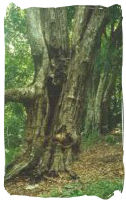 Flowers grow in bunches at end of branches. At the start of the rainy season long greenish buds appear; from the extremity of these the corolla comes which is of a lovely rosy peach color; as the corolla fades the calyx turns yellow, then red. The calyces, with the embryo seed, are at this stage beaten from the tree and when dried are the cloves of commerce. The flowers have a strong refreshing odor. If the seeds are allowed to mature, most of the pungency is lost. Each berry has only one seed. The trees fruit usually about eight or nine years after planting. The whole tree is highly aromatic. The fruit (cloves) are a great spice for baking with; has medicinal value as well. One of the main trading goods of the Schendi.
Flowers grow in bunches at end of branches. At the start of the rainy season long greenish buds appear; from the extremity of these the corolla comes which is of a lovely rosy peach color; as the corolla fades the calyx turns yellow, then red. The calyces, with the embryo seed, are at this stage beaten from the tree and when dried are the cloves of commerce. The flowers have a strong refreshing odor. If the seeds are allowed to mature, most of the pungency is lost. Each berry has only one seed. The trees fruit usually about eight or nine years after planting. The whole tree is highly aromatic. The fruit (cloves) are a great spice for baking with; has medicinal value as well. One of the main trading goods of the Schendi.
Etymology:alteration (probably influenced by clove) of Middle English clowe, cloue, from Old French clou (de girofle), literally, nail of clove, from Latin clavus nail;
1a : The pungent fragrant aromatic reddish brown dried flower bud of a tropical tree;
1b: A spice consisting of whole or ground cloves;
2: A moderate-sized very symmetrical red-flowered tropical evergreen tree (Eugenia caryophyllata or Syzygium aromaticum) of the family Myrtaceae that is probably native to the Moluccas but is now widely cultivated in the tropics (as Zanzibar and Madagascar) for its flower buds which are the source of cloves." — Merriam-Webster Dictionary ©2004-2006.
"Yes," I said. "It is cinnamon and cloves, is it not?"
"Yes," said Ulafi, "and other spices, as well." — Explorers of Gor, page 98.
Corn
Vegetable grown in agricultural communities in the Barrens; known in the language of the red savages as "Wagmu." 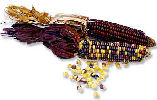
Etymology: Middle English, from Old English; akin to Old High German & Old Norse korn grain, Gothic kaurn, Latin granum;
"The kernels of sweet corn or maize served as a vegetable while still soft and milky; a plant that produces corn, the stalks and ears after reaping, or the ears ready for threshing." — Merriam-Webster Dictionary ©2004-2006.
"They grow produce for their masters, such as wagmeza and wagmu, maize, or corn, and such things as pumpkins and squash." — Savages of Gor, page 234.
Dates
The sweet fruit of the date palm, dates are the staple diet of the people of the Tahari. Dates are the principal export of the city of Tor; they are sold by the tef and tefa, and commercially sold in the form of pressed bricks. See "Palm Trees."
Date Palm
See "Palm Trees."
Dina A small, short-stemmed multi-petaled flower; indigenous to hillsides in the northern temperate zones. The dina resembles that of an Earth rose, though it is also described as being alien, which tells us then, that it is not the rose found on Earth. The dina is sometimes called the "slave flower" and is often used as a design for slave brands.
"… the dina is a small, lovely, multiply petaled flower, short-stemmed, and blooming in a turf of green leaves, usually on the slopes of hills, in the northern temperate zones of Gor; in its budding, though in few other ways, it resembles a rose; it is an exotic, alien flower; it is also spoken of, in the north, where it grows most frequently, as the slave flower…" — Slave Girl of Gor, page 61.
Evergreen Tree On Gor, known as the "Needle Tree." See: "Needle Tree."
Ferns
No information on the species of this tropical plant; most likely related to the ferns of earth.  Ferns are often found planted in public baths and gardens.
Ferns are often found planted in public baths and gardens.
Etymology: Middle English fern, ferne, from Old English fearn; akin to Old High German farn fern, Middle Irish raith fern;
"Any of numerous nonflowering vascular plants constituting a class (Filicineae) of the division Tracheophyta; especially : a plant of the order Filicales resembling seed plants in being differentiated into root, stem, and leaflike fronds and in having vascular tissue but differing in reproducing by spores that are borne usually in sori on fertile fronds or fertile portions of vegetative fronds and that upon germination commonly produce a flat typical thallus which produces antheridia and archegonia upon its surface, the egg of the archegonium giving rise to the sporophyte which is the conspicuous generation in the life cycle." — Merriam-Webster Dictionary ©2004-2006.
"Though the pool was marble and the walkways about it, much of the area was planted with grass and ferns and various other flora were in abundance." — Assassin of Gor, page 164.
Festal
A type of shrub. No specific information is given on this shrub. It is, perhaps, the festal found on Earth.
On Earth, festal is an herb native to southern Russia and into such Middle Eastern areas as Lebanon and Israel. The history of the festal plant dates to ancient times, and has played a key herb in religious festivals (festals) and ceremonies, such as Passover; sometimes known as "willow herb" though not related to the willow. Festal is used medicinally for such purposes as indigestion, dyspepsia, liver diseases, inflammatory diseases of stomach or bowels. Side effects include allergic reactions, diarrhea, nausea, abdominal pains, increased uric acid in the blood. In cases of over dosage the level of uric acid content in the blood plasma and urine will increase.
From the poem, "The Sabbath"
"Glorious Sabbath! Festal day!
Blessings bright around me play—
Crown my head, caress my feet,
Gifts of Heaven, my soul thus greet,
Through my placid hours so sweet!
Seems more festal herb and flower—
Glows parterre—more beauteous bower;
Seems now flowered mead more fair;
More perfumed the balmy air; …"
"What sort of shrubbery?" I asked.
"Some festal," he said, "some tes, a bit of tor." — Vagabonds of Gor, page 339.
Flahdah A tree of the Tahari having lanceolate leaves and narrow branches, with umbrella-like tops; the trunk leans, making the tree appear crooked. These trees play an important part in the life of the nomads of the desert, offering a brief respite of shade.
Lanceolate:
Etymology: Late Latin lanceolatus, from Latin lanceola, diminutive of lancea; Date: circa 1760;
"Shaped like a lance head; specifically : tapering to a point at the apex and sometimes at the base as in "lanceolate leaves" and "lanceolate prisms." — Merriam-Webster Dictionary ©2004-2006.
"Occasionally we passed a water hole, and the tents of nomads. About some of these water holes there were a dozen or so small trees, flahdah trees, like hat-topped umbrellas on crooked sticks, not more than twenty feet high; they are narrow branched, with lanceolate leaves. About the water, little more than muddy, shallow ponds, save for the flahdahs, nothing grew; only dried, cracked earth, whitish and buckled, for a radius of more than a quarter of a pasang, could be found; what vegetation there might have been had been grazed off, even to the roots; one could place one's hand in the cracks in the earth; each crack adjoins others to constitute an extensive reticulated pattern; each square in this pattern is shallowly concave. The nomads, when camping at a watering place, commonly pitch their tent near a tree; this affords them shade; also they place and hang goods in the branches of the tree, using it for storage." — Tribesmen of Gor, pages 71-72.
Flaminium A large scarlet flower having five petals.
"There was a shallow bowl of flowers, scarlet, large-budded, five-petaled flaminiums, on the small, low table between us." — Hunters of Gor, page 154.
Garlic
Great for Warriors' blood pressure. Genus name: Allium sativum The bulb of a member of the lily family, it is unknown from the wild. Garlic has actually evolved under cultivation during the past 5,000 years. 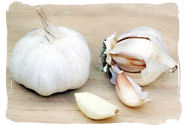 Garlic has been used as food and medicine since the age of the Egyptian pharaohs. The Greek historian and traveler Herodotus (484-425 B.C.) wrote that inscriptions on an Egyptian pyramid recorded the quantities of garlic consumed by the laborers. The Roman naturalist Pliny the Elder (A.D. 23-79) declared, "Garlic has powerful properties, and is of great benefit against changes of water and of residence."
Garlic has been used as food and medicine since the age of the Egyptian pharaohs. The Greek historian and traveler Herodotus (484-425 B.C.) wrote that inscriptions on an Egyptian pyramid recorded the quantities of garlic consumed by the laborers. The Roman naturalist Pliny the Elder (A.D. 23-79) declared, "Garlic has powerful properties, and is of great benefit against changes of water and of residence."
"I have peas and turnips, garlic and onions in my hut." — Outlaw of Gor, page 29.
Gorean Peach
No mention is made in the books as to the nature of the plantlife which bears a yellow, fleshy fruit;  most likely a tree as on Earth.
most likely a tree as on Earth.
"The fruit — grapes and peaches of some sort — was fresh and as cold as mountain snow." — Tarnsman of Gor, page 22.
"Another device, common in Port Kar, is for the girl to kneel before the master and put her head down and lift her arms, offering him fruit, usually larma, or a yellow Gorean peach, ripe and fresh." — Tribesmen of Gor, pages 27-28.
"The girl lifted her head then and timidly lifted the ripe, rounded fruit which she held in her hands. Gorean peaches and plums, to me." — Rogue of Gor, page 194.
Gorean Pear
No mention is made in the books as to the nature of the plantlife which bears a yellow fruit;  most likely a tree as on Earth. It seems that Goreans enjoy the pear with cheese embedded within the fruit.
most likely a tree as on Earth. It seems that Goreans enjoy the pear with cheese embedded within the fruit.
"In her hand there was a half of a yellow Gorean pear, the remains of a half moon of verr cheese imbedded in it." — Explorers of Gor, page 62.
Gorean Plum
No mention is made in the books as to the nature of the plantlife which bears a fruit by this name;  most likely a tree as on Earth..
most likely a tree as on Earth..
"From the garment, to the sand about her ankles, there fell several small Gorean plums…" — Hunters of Gor, page 92.
"I had nearly stepped into a basket of plums." — Tribesmen of Gor, page 45.
"The girl lifted her head then and timidly lifted the ripe, rounded fruit which she held in her hands. Gorean peaches and plums, to me." — Rogue of Gor, pages 194.
Gourds
Unspecified gourds; mention of the gourd in the following quote sounds like a type of yellow squash. 
Etymology: Middle English gourde, from Middle French, from Latin cucurbita, probably of non-Indo-European origin like Latin cucumer-, cucumis cucumber;
"1a (chiefly Britain): A cucurbitaceous fruit (as a cucumber, watermelon, or squash);
1b(1): any of numerous hard-rinded inedible usually large fruits (as a bottle gourd) of vines of the genus Lagenaria extensively used for vessels and utensils — called also calabash;
1b(2): any of numerous hard-rinded inedible small fruits derived from a natural variety of the pumpkin (Cucurbita pepo) — called also ornamental gourd;
2: A cucurbitaceous plant whose fruits are gourds;
3: Any of various hard-rinded fruits (as of the calabash tree) resembling or used like gourds;
4: A cleaned dried shell of a gourd used as a dipper or water bottle." — Merriam-Webster Dictionary ©2004-2006.
"Then she took a long draught of water from a yellow, curved gourd… she put the plug, carved from gourd stem, back in the gourd, and replaced it in the corner." — Raiders of Gor, page 34.
Grasses
In times of hunger, men of the seas often chew on these plants of the sea.  Here are a couple of quotes, evidences of Norman's contradictions, of a Tuchuk eating something which touched the dirt. Although they are only gaining the moisture from the grasses, it is still partaking of something which touched the dirt.
Here are a couple of quotes, evidences of Norman's contradictions, of a Tuchuk eating something which touched the dirt. Although they are only gaining the moisture from the grasses, it is still partaking of something which touched the dirt.
"He picked up a stalk of a patch of violet grass, one of several hues used in such gardens, and began to chew on it." — Nomads of Gor, pages 216-217.
"In the morning, before dawn, we awakened and fed on dried bosk meat, sucking the dew from the prairie grass." — Nomads of Gor, page 261.
Hemp
Hemp is mentioned only briefly in the books, with no detail that this hemp differs to the hemp plant of earth. I've seen sites try to use the quote from the books to justify marijuana use as part of Gorean role play. 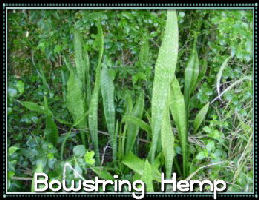 In the quote, reference to the hemp is clearly the Bowstring Hemp and not the cannibis these other sites are intimating.
In the quote, reference to the hemp is clearly the Bowstring Hemp and not the cannibis these other sites are intimating.
Etymology: Middle English hemp, hempe, from Old English hænep, henep; akin to Middle Dutch hennep hemp, Old High German hanaf, hanif, Old Norse hampr; probably all of non-Indo-European origin; akin to the source of Greek kannabis hemp & Armenian kanap;
Bowstring Hemp
"1a: A tall widely cultivated Asiatic herb (Cannabis sativa) with tough bast fiber that is used for making cloth, floor covering, and cordage — see bhang, cannabidiol, cannabin, cannabinol, cannabis, charas, hashish; compare ganja; b: the fiber of this plant prepared for commercial use; c: a narcotic drug (as hashish) from hemp
2: The useful fiber of any of numerous plants (as jute, abaca, ramie) other than hemp; also : the plant producing such fiber
3: archaica: A gallows rope b: hanging;
4: a light grayish olive color that is redder and deeper than twine, Quaker gray, or average citron gray." — Merriam-Webster Dictionary ©2004-2006.
African Bowstring Hemp
"Any of various Asiatic and African plants of the genus Sansevieria — see African Bowstring Hemp, Ife, Murva, Pangane;
2: the soft tenacious leaf fiber of bowstring hemp used in making bowstrings, cordage, and cloth and in packing;
3: Mudar
African Bowstring Hemp
A bowstring hemp (Sansevieria guineensis) of tropical Africa."
Aloe Hemp
"Any plant of the genus Agave that yields a hemplike fiber; bowstring hemp."
Kenaf
Etymology: Persian
"1: a valuable fiber plant (Hibiscus cannabinus) of the East Indies now widespread in cultivation
2: the fiber of kenaf used for cordage and canvas manufacture — called also ambari, bastard jute, Bombay hemp, deccan hemp, Java jute." — Merriam-Webster Dictionary ©2004-2006.
"Thurnock, though in Port Kar, had found a piece of Ka-la-na stock, and had been carving a great bow, the long bow. I knew he had also found some bits of bosk horn, and some leather, and some hemp and silk. In two or three days, I expected, he, too, would have a bow. Piles he had already commissioned from a smith; and Thura, on his command, this afternoon, with a bit of stick, had struck down a Vosk gull, that the shafts he fashioned, whether from Ka-la-na or tem-wood, would be well fletched." — Raiders of Gor, page 112.
Hogarthe Tree
A white-barked tree found in the Barrens, these trees are generally found growing along the banks of small streams or muddy, sluggish rivers. 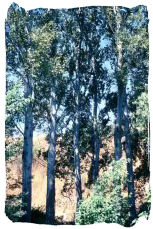 Similar to the poplar trees of earth; named for one of the early explorers of the area. There has been debate on whether this tree is the "white willow" thus bearing argument that "willow-bark" would be available on Gor. However, the true white willow is not a poplar. Too, the willow-bark used is obtained from the darker species of the willow family, not the white willow. There are white-barked poplars, and the following quote denotes that the trees are of poplar origin. Pictured is a white poplar tree.
Similar to the poplar trees of earth; named for one of the early explorers of the area. There has been debate on whether this tree is the "white willow" thus bearing argument that "willow-bark" would be available on Gor. However, the true white willow is not a poplar. Too, the willow-bark used is obtained from the darker species of the willow family, not the white willow. There are white-barked poplars, and the following quote denotes that the trees are of poplar origin. Pictured is a white poplar tree.
"On the rise were two trees, white-barked trees, some fifty feet tall, with shimmering green leaves. They stood within some thirty to forty feet of one another and bother were outlined dramatically against the sky. … They were Hogarthe trees, named for Hogarthe, one of the early explorers in the area of the Barrens. They are not uncommon in the vicinity of water in the Barrens, usually growing along the banks of small streams or muddy, sluggish rivers. Their shape is very reminiscent of poplar trees on Earth, to which, perhaps, in virtue of seeds brought to the Counter-Earth, they may be related." — Blood Brothers of Gor, page 300.
Ka-la-na Tree A tree with very strong, supple yellow wood; it bears a fruit which is fermented into an incandescent potent red wine. The supple wood of the tree is used for a variety of things, specifically in the making of bows and for ships, in the making of capstans and mastheads.
"… and drops of a red, winelike drink made from the fruit of the Ka-la-na tree." — Tarnsman of Gor, page 68.
"I was more pleased on the second day and made camp in a grassy veldt, dotted with the Ka-la-na trees." — Tarnsman of Gor, page 73.
"I set her down on a bed of green clover. Beyond it, some hundred yards away, I could see the border of a yellow field of Sa-Tarna and a yellow thicket of Ka-la-na trees." — Tarnsman of Gor, page 96.
"Over there," I said, "are some Ka-la-na trees. Wait here and I'll gather some fruit." — Tarnsman of Gor, page 96.
"I picked some Ka-la-na fruit…" — Tarnsman of Gor, pages 114-115.
"The logs had been prepared and carefully placed. There were hundreds of them, trimmed and squared, mostly of Ka-la-na wood, from the sweet-smelling wine trees of Gor." — Assassin of Gor, page 1.
I crossed the Cartius on a barge, one of several hired by the merchant of the caravan with which I was then seeing. These barges, constructed of layered timbers of Ka-la-na wood, are towed by teams of river tharlarion, domesticated, vast, herbivorous, web-footed lizards raised and driven by the Cartius bargemen, fathers and sons, interrelated clans, claiming the status of a cast for themselves." — Nomads of Gor, pages 3-4 (footnote).
"Ho-Hak reached down and unwrapped the leather from the yellow bow of supple Ka-la-na." — Raiders of Gor, page 19.
"Port Kar is, incidentally, completely dependent on the northern timber. Tur wood is used for galley frames, and beams and clamps and posts, and for hull planking; Ka-la-na serves for capstans and mastheads; Tem-wood for rudders and oars; and the needle trees, the evergreens, for masts and spars, and cabin and deck planking." — Raiders of Gor, page 141.
Kanda
The leaf of this shrub is often chewed for its narcotic value as a pain killer. Because it is a narcotic, it is extremely addictive and over-use of the leaf is frowned upon. The root of the kanda, when ground and boiled makes an extremely deadly poison.
"On the twentieth day of the siege there was great rejoicing in the camp of Pa-Kur, because in one place the wires had been cut and a squad of spearmen had reached the main siege reservoir, emptying their barrels of toxic kanda, a lethal poison extracted from one of Gor's desert shrubs." — Tarnsman of Gor, page 179.
"Most was I surprised to find him holding a tiny, round pipe from which curled a bright wisp of smoke. Tobacco is unknown on Gor, though there are certain vices or habits to take its place, in particular the stimulation afforded by chewing on the leaves of the Kanda plant, the roots of which, oddly enough, when ground and dried, constitute an extremely deadly poison." — Priest-Kings of Gor, pages 24-25.
"Kutaituchik absently reached into a small golden box near his right knee and drew out a string of rolled kanda leaf. The roots of the kanda plant, which grows largely in desert regions on Gor, are extremely toxic, but, surprisingly, the rolled leaves of this plant, which are relatively innocuous, are formed into strings and, chewed or sucked, are much favored by many Goreans, particularly in the southern hemisphere, where the leaf is more abundant. Kutaituchik, not taking his eyes off us, thrust one end of the green kanda string in the left side of his mouth and, very slowly, began to chew it." — Nomads of Gor, page 44.
"Much more dangerous is the poison lock, because the opening through which the tiny pins, usually coated with a paste formed from kanda root, can emerge can be extremely small, almost invisible to the eye, easy to overlook in the crevices and grillwork of the commonly heavy, ornate Gorean lock." — Assassin of Gor, page 52.
Katch
A foliated leaf vegetable; similar to a cabbage.
"A great amount of farming, or perhaps one should speak of gardening, is done at the oasis, but little of this is exported. At the oasis will be grown a hybrid, brownish Sa-Tarna, adapted to the heat of the desert; most Sa-Tarna is yellow; and beans, berries, onions, tuber suls, various sorts of melons, a foliated leaf vegetable, called Katch, and various root vegetables, such as turnips, carrots, radishes, of the sphere and cylinder varieties, and korts, a large, brownish-skinned, thick-skinned, sphere-shaped vegetable, usually some six inches in width, the interior of which is yellowish, fibrous and heavily seeded. At the oasis, because of the warm climate, the farmers can grow two or more crops a year." — Tribesmen of Gor, page 37.
Kes Shrub A shrub whose salty, blue secondary roots are a main ingredient in sullage.
"The principal ingredients of Sullage are the golden Sul, the starchy, golden-brown vine-borne fruit of the golden-leaved Sul plant; the curled, red, ovate leaves of the Tur-Pah, a tree parasite, cultivated in host orchards of Tur trees; and the salty, blue secondary roots of the Kes Shrub, a small, deeply rooted plant which grows best in sandy soil." — Priest-Kings of Gor, pages 44-45.
Kort
A large, brown-skinned, thick-skinned sphere sphere-shaped vegetable, about 6 inches wide, yellow and fibrous inside, heavily seeded.
"A great amount of farming, or perhaps one should speak of gardening, is done at the oasis, but little of this is exported. At the oasis will be grown a hybrid, brownish Sa-Tarna, adapted to the heat of the desert; most Sa-Tarna is yellow; and beans, berries, onions, tuber suls, various sorts of melons, a foliated leaf vegetable, called Katch, and various root vegetables, such as turnips, carrots, radishes, of the sphere and cylinder varieties, and korts, a large, brownish-skinned, thick-skinned, sphere-shaped vegetable, usually some six inches in width, the interior of which is yellowish, fibrous and heavily seeded. At the oasis, because of the warm climate, the farmers can grow two or more crops a year." — Tribesmen of Gor, page 37.
"I had had verr meat, cut in chunks and threaded on a metal rod, with slices of peppers and larma, and roasted; vulo stew with raisins, nuts, onions and honey; a Kort with melted cheese and nutmeg; hot Bazi tea, sugared, and, later, Turian wine." — Tribesmen of Gor, pages 47-48.
"I detected the odor of kort rinds, matted, drying, on the stones, where they had been scattered from my supper the evening before." — Tribesmen of Gor, page 115.
Larma Tree
This tree, cultivated in orchards generally, bears two distinct forms of fruit.
The Hard Larma is, as the name implies, a firm, single-seeded apple-like fruit, also called the "pit fruit."
"I took a slice of hard larma from the tray. This is a firm, single-seeded applelike fruit. It is quite unlike the segmented, juicy larma. It is sometimes called, perhaps more aptly, the pit fruit, because of its large single stone." — Players of Gor, page 267.
The Segmented Larma is, as the name implies, segmented, sweet and juicy, the flesh red in color; though it sounds much like the pomegranate, yet pomegranates are later described as pomegranates.
"He then picked up a juicy, red larma fruit, biting into it with a sound that seemed partly crunching as he went through the shell, partly squishing as he bit into the fleshy, segmented endocarp." — Nomads of Gor, page 220.
The Torian larma fruit is not fully described as either the hard larma, or the segmented larma.
"And put bread over the fire," I said, "and honey, and the eggs of vulos, and fried tarsk meat and a Torian larma fruit." — Assassin of Gor, page 106.
"A great amount of farming, or perhaps one should speak of gardening, is done at the oasis, but little of this is exported… Larma and tospits are also grown at the oases, in small orchards." — Tribesmen of Gor, page 37.
"The slave boy, Fish, had emerged from the kitchen, holding over his head on a large silver platter a whole roasted tarsk, steaming and crisped, basted, shining under the torchlight, a larma in its mouth, garnished with suls and Tur-pah." — Raiders of Gor, page 219.
"I had had verr meat, cut in chunks and threaded on a metal rod, with slices of peppers and larma, and roasted…" — Tribesmen of Gor, page 47.
"Another device, common in Port Kar, is for the girl to kneel before the master and put her head down and lift her arms, offering him fruit, usually a larma, or a yellow Gorean peach, ripe and fresh." — Tribesmen of Gor, pages 27-28.
Leech Vine
A hemovorous plant, vine-like and tendriled, that fastens two hollow, fang-like thorns into its victim, through which it can suck the blood that nourishes it; primarily dangerous to children and small animals, although even a grown man fallen into a patch is not likely to survive.
It was suggested on a once "official" site that the leech plant is derived from prehistoric times on Earth. Not only is prehistoric times one of my passions, I used to have a greenhouse and cultivated a few varieties of carnivorous plants. While prehistoric times hosted varieties of carnivorous plants, there has been no evidence found of any prehistoric plantlife known for bloodsucking, uprooting or crawling to capture its victim. In fact, the carnivorous plants have not much changed since those pre-mankind eras in Earth history. Carnivorous plants, still in existence on Earth, are nothing quite like the leech plant of Gor. There are rare few carnivorous plants that feed off of small animals, like mice or birds. However, these animals, just as the insects that mostly feed these plants, must fall into their various forms of traps. The carnivorous plant, Nepenthes is the only such plant found sometimes in a vine form — and makes a wonderful addition to a greenhouse. It's a beautiful plant and a wonder to watch. None of my carnivorous plants I once had ever attempted to make their escape crawling from their pots, writhe in my hand, eat me or suck my blood.
The leech plant is likely inspired from the book, Day of the Triffids by John Wyndham. Or even the cartoon, Bullwinkle; a few episodes of this truly odd series includes a carnivorous vine called a Pennsylvania creeper. Who can forget Audrey II from Little Shop of Horrors? There have been other countless movies, TV shows and books utilizing evil carnivorous vines and plantlife that move on their own.
"Once I shouted in pain. Two fangs had struck into my calf. An ost, I thought! But the fangs held fast, and I heard the popping, sucking sound of the bladderlike seed pods of a leech plant, as they expanded and contracted like small ugly lungs. I reached down and jerked the plant from the soil at the side of the road. It writhed in my hand like a snake, its pods gasping. I jerked the two fanglike thorns from my leg. The leech plant strikes like a cobra, and fastens two hollow thorns into its victim. The chemical responses of the bladderlike pods produce a mechanical pumping action, and the blood is sucked into the plant to nourish it. As I tore the thing from my leg, glad that the sting had not been that of the venomous ost, the three hurtling moons of Gor broke from the dark cover of the clouds. I held the quivering plant up. Then I twisted it apart. Already my blood, black in the silvery night, mixed with the juices of the plant, stained the stem even to the roots. In a matter of perhaps two or three seconds, it had drawn perhaps a gill of liquid. With a shudder I hurled the loathsome plant away from the road. Normally such plants are cleared away from the sides of the roads and from inhabited areas. They are primarily dangerous to children and small animals, but a grown man who might lose his footing among them would not be likely to survive." — Outlaw of Gor, pages 33-34.
"Once I stopped to rest. I lay, panting on the grass. My eyes were closed. I heard a rustle. I turned my head and opened my eyes. I watched it in terror. It was vinelike, and tendriled, leaved. A blind, split, podlike head was moving toward me, lifting itself slightly from the ground, moving from side to side. Inside the pod I could see, fastened in the upper surface, too long, curved, thornlike fangs. I screamed, leaping to my feet. The thing suddenly struck at me. It tore through the fabric of the slacks on my right leg. I pulled my leg away, tearing away the cloth. It struck again and again, as though sensing me by smell or heat, but it was rooted, and I was beyond its reach. I threw back my head, my hands to the sides of my head, and screamed. I heard another rustle, near me. I looked about, wildly, I saw the other plant, and then two others, too. And then another." — Captive of Gor, page 41.
"Then I stepped warily, for I saw, to one side, a patch of the dark, tendriled vinelike plants. I stood to one side and, fascinated, watched them rustle, sensing my presence. Several of the fanged seedpods lifted, like heads, sensing me, moving back and forth gently. But I was no longer much afraid of them. I now knew their danger." — Captive of Gor, pages 44-45.
Liana Vine
A jungle vine of the Schendi. When cut open, small amounts of water may be extracted from the vine to drink. 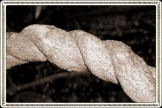 The strong vine is also used in the making of rafts. On earth, lianas are the slow-growing highways of the neo-tropical rainforests. Many species of animals use the lianas to move between the forest canopy and the forest floor, especially monkeys and sloths. Since lianas normally grow only 1cm per year, this liana is between 200 and 300 years old. Thick lianas are the only sure sign of old-growth rainforest, as many tropical hardwood trees do not have the annual "rings" like temperate trees. Lianas typically comprise 15% of the biomass of a tropical rainforest.
The strong vine is also used in the making of rafts. On earth, lianas are the slow-growing highways of the neo-tropical rainforests. Many species of animals use the lianas to move between the forest canopy and the forest floor, especially monkeys and sloths. Since lianas normally grow only 1cm per year, this liana is between 200 and 300 years old. Thick lianas are the only sure sign of old-growth rainforest, as many tropical hardwood trees do not have the annual "rings" like temperate trees. Lianas typically comprise 15% of the biomass of a tropical rainforest.
Etymology: French liane, from French dialect liône, lieune, liane, probably from lier to bind, tie;
"A climbing plant that roots in the ground with woody lianas being characteristic of tropical rain forests and herbaceous lianas of temperate regions." — Merriam-Webster Dictionary ©2004-2006.
"We stood near the mud raft, that raft of logs and liana vines on which we placed our shovelfuls of mud." — Explorers of Gor, page 244.
"Another useful source of water is the liana vine. One makes the first cut high, over one's head, to keep the water from being withdrawn by contraction and surface adhesion up the vine. The second cut, made a foot or so from the ground, gives a vine tube which, drained, yields in the neighborhood of a liter of water. In the rain forest some trees grow and lose leaves all year long, remaining always in foliage. Others, though not at the same time, even in the same species, will lose their foliage for a few weeks and then again produce buds and a new set of leaves. They have maintained their cycles of regeneration but these cycles, interestingly, are often no longer synchronized with either the northern or southern winters and springs." — Explorers of Gor, page 310.
Lichens
In times of hunger, men of the seas often chew on these mosslike plants which grow along rocks. Please also refer to the Foods and Gorean Medicine pages for further information.
Etymology: Latin, from Greek leich*n, lich*n, probably from leichein to lick;
"Any of numerous complex thallophytic plants that constitute the group Lichenes, that are made up of an alga and a fungus growing in symbiotic association on various solid surfaces (as rocks or the bark of trees), that consist of a branching thallus which is not differentiated into stem and leaves but which may be crustose, fruticose, or foliaceous and which contains algal gonidia embedded in a meshwork of fungal hyphae, and that include organisms important in the weathering and breakdown of rocks and some that are sources of foods or dyes; see Ascolichenes, Basidiolichenes; Iceland Moss, Reindeer Moss; Archil, Litmus." — Merriam-Webster Dictionary ©2004-2006.
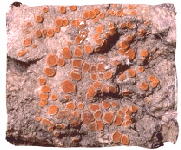 |
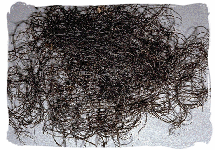 |
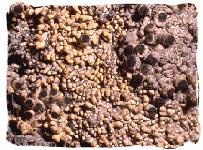 |
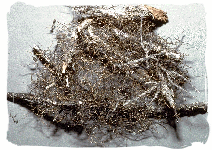 |
"There is often not enough food under any conditions, particularly I n northern Torvaldsland, and famine is not known. In such cases men feed on bark, and lichens and seaweed." — Marauders of Gor, page 55.
Maize
Indian corn; a vegetable grown in agricultural communities in the Barrens; known in the language of the red savages as "Wagmeza." 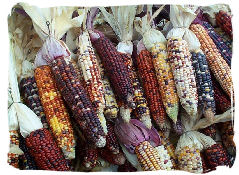 See: "Corn".
See: "Corn".
Etymology: Spanish maÍz, from Taino mahiz, mays;
"Indian corn; or maize yellow: a variable color averaging a light yellow that is redder and duller than jasmine or chrome lemon and redder and very slightly darker than popcorn." — Merriam-Webster Dictionary ©2004-2006.
"They grow produce for their masters, such as wagmeza and wagmu, maize, or corn, and such things as pumpkins and squash." — Savages of Gor, page 234.
Marsh Vine
Vine found in the marshes along the Vosk.
"I took the triangular-bladed tem-wood paddle and moved the small craft, light and narrow, large enough scarcely for one man, ahead. I was formed of pliant, tubular, lengthy Vosk rushes, bound with marsh vine." — Raiders of Gor, page 1.
"In many places it is too shallow to float even the great flat-bottomed barges and, more importantly, a path for them would have to be cut and chopped, foot by foot, through the thickets of rush and sedge, and the tangles of marsh vine." — Raiders of Gor, page 5.
Melons
A gourd-fruit; some varieties are yellow and red-striped (casaba melons possibly).
Etymology: Middle English meloun, from Middle French melon, from Late Latin melon-, melo, short for Latin melopepon-, melopepo, from Greek melopepon, from molon apple + pepon, a kind of edible gourd;
"Either of two soft-fleshed sweet-flavored pepos that are usually eaten raw as a fruit: (1): Muskmelon (2): Watermelon; a plant that bears melons." — Merriam-Webster Dictionary ©2004-2006.
Please Note: "celane melons" are not found in the books by John Norman; they are an mIRC creation. I have actually seen someone use the following quotes to demonstrate the evidence of "celane" melons. Perhaps "celane" translates to "various sorts" in her language? Refer to the Onlinisms page for more information on celane of Earth.
"A great amount of farming, or perhaps one should speak of gardening, is done at the oasis, but little of this is exported. At the oasis will be grown a hybrid, brownish Sa-Tarna, adapted to the heat of the desert; most Sa-Tarna is yellow; and beans, berries, onions, tuber suls, various sorts of melons, a foliated leaf vegetable, called Katch, and various root vegetables, such as turnips, carrots, radishes, of the sphere and cylinder varieties, and korts, a large, brownish-skinned, thick-skinned, sphere-shaped vegetable, usually some six inches in width, the interior of which is yellowish, fibrous and heavily seeded. At the oasis, because of the warm climate, the farmers can grow two or more crops a year." — Tribesmen of Gor, page 37.
"Buy melons! called a fellow next to her, lifting one of the yellowish red-striped spheres toward me." — Tribesmen of Gor, page 45.
Mint
It is not mentioned which form of garden variety mint plant (spearmint or peppermint) is found on Gor. 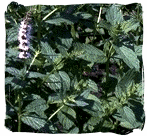 We do know that there has to be a mint plant as mint sticks were served as after dinner palate cleansers, as well as mint candies were often given to slave girls.
We do know that there has to be a mint plant as mint sticks were served as after dinner palate cleansers, as well as mint candies were often given to slave girls.
"On the tray, too, was the metal vessel which had contained the black wine, steaming and bitter, from far Thentis, famed for its tarn flocks, the small yellow-enameled cups from which we had drunk the black wine, its spoons and sugars, a tiny bowl of mint sticks, and the softened, dampened cloths on which we had wiped our fingers." — Explorers of Gor, page 10.
Mushrooms
Tasty fungus, served stuffed, often with tarsk sausage. 
"I am an Alar," Hurtha explained. "Have a stuffed mushroom." — Mercenaries of Gor, page 81.
I was particularly fond of stuffed mushrooms… "What are they stuffed with?" I asked Hurtha.
"Sausage," he said.
"Tarsk?" I asked.
"Of course," he said. — Mercenaries of Gor, page 83.
Needle Tree
An evergreen tree whose oil is used in perfumes;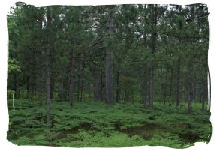 the wood of the tree is used in shipbuilding, specifically for masts, spars, cabin and deck planking.
the wood of the tree is used in shipbuilding, specifically for masts, spars, cabin and deck planking.
"Port Kar is, incidentally, completely dependent on the northern timber. Tur wood is used for galley frames, and beams and clamps and posts, and for hull planking; Ka-la-na serves for capstans and mastheads; Tem-wood for rudders and oars; and the needle trees, the evergreens, for masts and spars, and cabin and deck planking." — Raiders of Gor, page 141.
Nutmeg
Tree which bears a fruit which is ground producing a sweet spice; 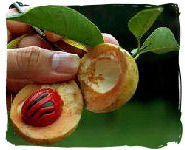 also has medicinal value.
also has medicinal value.
"I had had verr meat, cut in chunks and threaded on a metal rod, with slices of peppers and larma, and roasted; vulo stew with raisins, nuts, onions and honey; a Kort with melted cheese and nutmeg; hot Bazi tea, sugared, and, later, Turian wine." — Tribesmen of Gor, pages 47-48.
Nuts
There are no descriptions on what tree or other vegetation where they obtain these indescript nuts;  used in vulo stew, as well as in other dishes.
used in vulo stew, as well as in other dishes.
"Merchants brought sides of bosk, and thighs of tarsk, and wines and fruits to camp, and cheeses and breads and nuts, and flowers and candies and silks and honeys." — Captive of Gor, page 321.
"I had had verr meat, cut in chunks and threaded on a metal rod, with slices of peppers and larma, and roasted; vulo stew with raisins, nuts, onions and honey; a Kort with melted cheese and nutmeg; hot Bazi tea, sugared, and, later, Turian wine." — Tribesmen of Gor, pages 47-48.
Olives
Tree which bears an edible fruit, used often as garnishes.  There are two varieties mentioned in the books: those of Tor and the red-skinned of Tyros; possibly one and the same.
There are two varieties mentioned in the books: those of Tor and the red-skinned of Tyros; possibly one and the same.
"The Tarn Keeper, who was called by those in the tavern Mip, bought the food, bosk steak and yellow bread, peas and Torian olives, and two golden-brown, starchy Suls, broken open and filled with melted bosk cheese." — Assassin of Gor, page 167.
"Clitus, too, had brought two bottles of Ka-la-na wine, a string of eels, cheese of the verr and a sack of red olives from the groves of Tyros." — Raiders of Gor, page 114.
Onion
Presumably the same as Earth onions. 
"…who tumbled onions, turnips, radishes, potatoes and bread into the feed trough." — Outlaw of Gor, page 155.
"I have peas and turnips, garlic and onions in my hut." — Outlaw of Gor, page 29.
"He thrust an onion and a crust of bread into my hands." — Outlaw of Gor, page 148.
"I and the others, from our pans, were eating one of our four daily rations of bread, onions and peas." — Raiders of Gor, page 184.
"Their food is that of a galley slave, peas, black bread and onions. If they serve well, however, their customers often bring them a bit of meat or fruit." — Hunters of Gor, page 304.
"I saw too, fields, fenced with rocks, in the sloping area. In them were growing, small at this season, shafts of Sa-Tarna; too, there would be peas, and beans, cabbages and onions, and patches of the golden sul, capable of surviving at this latitude." — Marauders of Gor, page 81.
"A great amount of farming, or perhaps one should speak of gardening, is done at the oasis, but little of this is exported. At the oasis will be grown a hybrid, brownish Sa-Tarna, adapted to the heat of the desert; most Sa-Tarna is yellow; and beans, berries, onions, tuber suls, various sorts of melons, a foliated leaf vegetable, called Katch, and various root vegetables, such as turnips, carrots, radishes, of the sphere and cylinder varieties, and korts, a large, brownish-skinned, thick-skinned, sphere-shaped vegetable, usually some six inches in width, the interior of which is yellowish, fibrous and heavily seeded. At the oasis, because of the warm climate, the farmers can grow two or more crops a year. Larma and tospits are also grown at the oases, in small orchards. Some rep is grown, for cloth, but most cloth comes to the oases from caravans." — Tribesmen of Gor, page 37.
Palm Trees
More than 1500 varieties of palm trees exist in the rainforest;  one of which is the Fan Palm, more than twenty feet (20') high, and spreads it leaves in the form of a an opened fan, it is an excellent source of water, almost as though cupped, at the base of each leaf's stem.
one of which is the Fan Palm, more than twenty feet (20') high, and spreads it leaves in the form of a an opened fan, it is an excellent source of water, almost as though cupped, at the base of each leaf's stem.
"There is an incredible variety of trees in the rain forest, how many I cannot conjecture. There are, however, more than fifteen hundred varieties and types of palm alone. Some of these palms have leaves which are twenty feet in length. One type of palm, the fan palm, more than twenty feet high, which spreads its leaves in the form of an opened fan, is an excellent source of pure water, as much as a liter of such water being found, almost as though cupped, at the base of each leaf's stem." — Explorers of Gor, page 310.
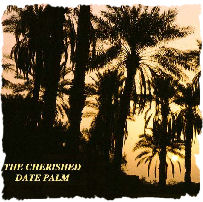 |
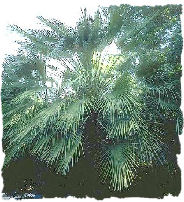 |
In the desert, the Date Palms are the source of the extremely valuable date. It takes ten years before the date palm can bear fruit and will then yield fruit for more than twenty-five (25) years thereafter. Annually, the date palm will yield approximately five (5) Gorean weights of fruit. Dates are the principal export of the city of Tor; they are sold by the tef and tefa, and commercially sold in the form of pressed bricks.
"The principal export of the oases is dates and pressed-date bricks. Some of the date palms grow to more than a hundred feet high. It takes ten years before they begin to bear fruit. They will then yield fruit for more than a century. A given tree, annually, yields between one and five Gorean weights of fruit." — Tribesmen of Gor, page 37.
"I counted eleven palm trees, date palms, cut down, their trunks fallen at an angle into the dust, the palm leaves dried and lifeless, the fruit unripened. It takes years for such a tree to grow to the point at which it will bear fruit." — Tribesmen of Gor, page 153.
Peas
Often specifically called "Gorean peas" by Tarl Cabot, there was nothing mentioned giving specifics as to how they may differ from Earth peas. 
"The Tarn Keeper… brought the food, bosk steak and yellow bread, peas and Torian olives, and two golden-brown, starchy Suls, broken open and filled with melted bosk cheese." — Assassin of Gor, page 168.
"After a bit of cold bosk, some water and a handful of peas, I had come the House of Cernus." — Assassin of Gor, page 40.
"I and the others, from our pans, were eating one of our four daily rations of bread, onions and peas." — Raiders of Gor, page 184.
"… a galley slave… The great merchant galleys of Port Kar, and Cos, and Tyros, and other maritime powers, utilized thousands of such miserable wretches, fed on brews of peas and black bread, chained in the rowing holds, under the whips of slave masters, their lives measured by feedings and beatings, and the labor of the oar." — Hunters of Gor, page 13.
"I saw too, fields, fenced with rocks, in the sloping area. In them were growing, small at this season, shafts of Sa-Tarna; too, there would be peas, and beans, cabbages and onions, and patches of the golden sul, capable of surviving at this latitude." — Marauders of Gor, page 81.
Peppers
Trees and viney shrubs which bear fruits (peppers) of varying types; some hot to very hot. 
Etymology: Middle English peper, from Old English pipor; akin to Old High German pfeffar pepper, Old Norse piparr; all from a prehistoric Germanic word borrowed from Latin piper pepper, from Greek peperi, probably from Sanskrit pippalilong pepper;
"1a : a pungent product obtained from the fruit of an East Indian plant (Piper nigrum), used as a condiment and sometimes as a carminative or stimulant, and prepared in a form (1) consisting of the entire dried berry or (2) consisting of the dried seeds divested of all membranes and pulp with both forms being usually ground into powder before use — called also (1) black pepper, (2) white pepper; b: any of several somewhat similar products obtained from other plants of the genus Piper — often used with a qualifying term; c: any of various pungent condiments obtained from plants other than those of the genus Piper;
2: a plant of the genus Piper; especially: a woody vine (Piper nigrum) with ovate leaves and spicate flowers that is native to the oriental tropics but widely cultivated in tropical regions for its red berries from which pepper is prepared;
3a : a plant of the genus Capsicum (especially C. frutescens;) b: the many-seeded berry enclosed in a thickened integument like an indehiscent pod that is the fruit of any of these plants, varies greatly in shape and size in different varieties, is usually red or yellow when ripe, and includes numerous cultivated forms used in the preparation of condiments and relishes and as vegetables;
4: any of numerous plants other than members of the genera Piper and Capsicum that have pungent or aromatic qualities — usually used with a qualifying term 'African pepper.'" — Merriam-Webster Dictionary ©2004-2006.
"Telima had prepared a roast tarsk, stuffed with suls and peppers from Tor." — Raiders of Gor, page 114.
"In the cafes I had feasted well. I had had verr meat, cut in chunks and threaded on a metal rod, with slices of peppers and larma, and roasted …" — Tribesmen of Gor, page 47.
"Some of the peppers and spices, relished even by children in the Tharai districts, were sufficient to convince an average good fellow of Thentis or Ar that the roof of his mouth and his tongue were being torn out of his head." — Tribesmen of Gor, page 46.
Pod Tree
Tree found in the Schendi region; 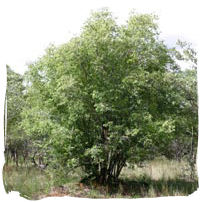 cloth is made from the bark, dyed scarlet and plaited and pounded into a cloth; often adorning the hips of slave girls in the Schendi region. There are several varieties of pod trees found on earth; the horn pod is used for several medicinal purposes. I'll explore four varieties; the first two being native to Africa, and most likely the pod tree of the Schendi region on Gor.
cloth is made from the bark, dyed scarlet and plaited and pounded into a cloth; often adorning the hips of slave girls in the Schendi region. There are several varieties of pod trees found on earth; the horn pod is used for several medicinal purposes. I'll explore four varieties; the first two being native to Africa, and most likely the pod tree of the Schendi region on Gor.
Horn-pod tree (Diplorhynchus condylocarpon):
The horn-pod tree of Africa is normally multi-stemmed with grey-blackish bark that flakes in squares. Grows up to 10 metres tall in open woodland and rocky slopes. The horn-pod tree contains a milky latex which when stirred makes a soft rubber. The latex has been used as birdlime (the latex is spread on branches where birds roost. When they land on the latex they stick to it and can not fly away.) The latex is also applied to the hides of drums to improve tone. The shape of the fruit gives the horn-pod tree its name. The pods dry out in winter. Then they crack and open to drop 2-4 large seeds with membraneous wings. An infusion of the roots is used to treat diarrhea.A decoction of the root was used to relieve the symptoms of black-water fever. Headaches were cured with an infusion of the leaves. The horn-pod tree is fire resistant and can survive early burning. Kudu have been seen browsing new leaves at the beginning of summer. The wood of the horn-pod tree is light brown with a fine grain.
Copper Pod Tree (Peltophorum Pterocarpum):
Common name: yellow poinciana, copper pod tree; Family: leguminoceae. The yellow poinciana is an upright, semi - evergreen tree, growing up to 50' tall. It has dark green leathery leaflets, fragrant, yellow flowers and alongated seedpod. This tree is common in the U.S.A.Sjambok Pod (Cassia abbreviata):
This is a deciduous tree, which may reach 13m in height.This tree occurs at low altitudes, found in open woodland and wooded grassland. Along rivers, on hillsides and are often found near termite mounds. The bark is rough in texture and is brownish grey in color. The flowers are pale yellow in color and slender in shape and produced during the months of September to October. Fruit of the trees is produced during December to April. The fruit is long and cylindrical, being golden brown to brown in coloration. Various parts of the tree are used medicinally, with seeds being sucked as a tonic. The roots relieve abdominal pains and toothache. Smoke from burning twigs is inhaled to relieve headaches. Certain tribes were using a remedy made from the roots to treat Black Water Fever. The Shangaans of old would cook their meat along side bits of bark from this tree, believed to have magical powers and ensure good hunting.
Monkey Pod Tree:
The Monkey Pod tree is a shade tree that lives in tropical climates. They have short, stout trunks and long branches. Some trees measure about 100 feet across. When the wind hits the pods they make a rattling sound. This tree is common in such areas as Hawaii.
"The results of our trading had been two baskets of dried fish, a sack of meal and vegetables, a length of bark cloth, plaited and pounded, from the pod tree, dyed red…" — Explorers of Gor, page 287.
Pomegranate
The tree which produces hard shelled, red, fleshy, segmented fruits. The juice is used in making liqueurs and meat marinades (grenadine).
Etymology: Middle English poumgrenet, from Middle French pomme grenate, literally,
seedy apple; Date: 14th century;
"1: a thick-skinned several-celled reddish berry that is about the size of an orange and has many seeds with pulpy crimson arils of tart flavor;
2: a widely cultivated tropical Old World tree (Punica granatum of the family Punicaceae) bearing pomegranates." —Merriam-Webster Dictionary ©2004-2006Pomegranate:The fruit of (Punica granatum,( a bush or small tree of Asia, which with a little-known species from the island of Socotra constitutes the family Punicaceae. The plant, which may attain 5 or 7 metres (16 or 23 feet) in height,has elliptic to lance-shaped, bright-green leaves about 75 millimetres (3 inches) long and handsome axillary orange-red flowers borne toward the ends of the branchlets. The calyx is tubular and persistent and has five to seven lobes; the petals are lance-shaped, inserted between the calyx lobes. The ovary is embedded in the calyx tube and contains several compartments in two series, one above the other.
The fruit is the size of a large orange, obscurely six-sided, with a smooth, leathery skin that ranges from brownish yellow to red; within, it is divided into several chambers containing many thin, transparent vesicles of reddish, juicy pulp, each surrounding an angular, elongated seed. The fruit is eaten fresh, and the juice is the source of (grenadine syrup,( used in flavourings and liqueurs.
Throughout the Orient, the pomegranate has since earliest times occupied a position of importance alongside the grape and the fig. According to the Bible, King Solomon possessed an orchard of pomegranates, and, when the children of Israel, wandering in the wilderness, sighed for the abandoned comforts of Egypt, the cooling pomegranates were remembered longingly. Centuries later, the prophet Muhammad remarked, "Eat the pomegranate, for it purges the system of envy and hatred." While the pomegranate is considered indigenous to Iran and neighbouring countries, its cultivation long ago encircled the Mediterranean and extended through the Arabian Peninsula, Afghanistan, and India. It is commonly cultivated in the Americas from the warmer parts of the United States to Chile. Though the pomegranate grows in a wide range of climates, good fruit is produced only where high temperatures and dry atmosphere accompany the ripening period." —Encyclopaedia Britannica ©2004-2006
"From outside I could smell date palms, pomegranates." — Tribesmen of Gor, page 115.
"Pomegranate orchards lie at the east of the oasis." I said. — Tribesmen of Gor, page 174.
Potato
A root vegetable of that is suspiciously like the Sul.  Did John Norman forget he created the Sul? Or was he confirming that the potato is, in fact, the sul of Gor?
Did John Norman forget he created the Sul? Or was he confirming that the potato is, in fact, the sul of Gor?
"…who tumbled onions, turnips, radishes, potatoes and bread into the feed trough." — Outlaw of Gor, page 155.
Prairie Grass
Grass commonly found on prairies and meadowlands, specifically, the Plains of Turia and the Barrens; 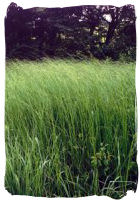 grazing fodder for the ruminants such as the bosk, kailiauk, Barrens kaiila, and tabuk, et al.
grazing fodder for the ruminants such as the bosk, kailiauk, Barrens kaiila, and tabuk, et al.
"… the prairie grass, such that it might graze the ponderous bosk, had been spared." — Nomads of Gor, page 4.
Pumpkin
A spherical gourd/vegetable grown in agricultural communities in the Barrens. 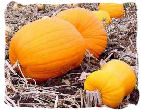
Etymology: alteration (influenced by -kin) of pumpion, pompion, modification of Middle French popon, pompon pumpkin, melon, from Latin pepon-, pepo, from Greek pepon an edible gourd, from pepon cooked by sun, ripe, from peptein, pessein to cook, ripen, digest;
"Any of various usually firm-rinded fruits of vines of the genus Cucurbita that are widely cultivated as a vegetable, for pies, and for livestock feed; any of numerous usually large rounded and deep yellow to orange fruits produced by plants that are horticultural varieties of the natural species (C. pepo)." — Merriam-Webster Dictionary ©2004-2006.
"They grow produce for their masters, such as wagmeza and wagmu, maize, or corn, and such things as pumpkins and squash." — Savages of Gor, page 234.
Radish
Small root vegetable with a zing. 
"…who tumbled onions, turnips, radishes, potatoes and bread into the feed trough." — Outlaw of Gor, page 155.
"Ottar dug for the Forkbeard and myself two radishes and we, wiping the dirt from them, ate them." — Marauders of Gor, page 102.
"A great amount of farming, or perhaps one should speak of gardening, is done at the oasis, but little of this is exported. At the oasis will be grown a hybrid, brownish Sa-Tarna, adapted to the heat of the desert; most Sa-Tarna is yellow; and beans, berries, onions, tuber suls, various sorts of melons, a foliated leaf vegetable, called Katch, and various root vegetables, such as turnips, carrots, radishes, of the sphere and cylinder varieties, and korts, a large, brownish-skinned, thick-skinned, sphere-shaped vegetable, usually some six inches in width, the interior of which is yellowish, fibrous and heavily seeded. At the oasis, because of the warm climate, the farmers can grow two or more crops a year." — Tribesmen of Gor, page 37.
Ram-berry
Not really a berry, these are a somewhat small, reddish fruit, similar to a plum except that it has many seeds, native to Gor.
"A guard was with us, and we were charged with filling our leather buckets with ram-berries, a small, reddish fruit with edible seeds, not unlike tiny plums, save for the many small seeds." — Captive of Gor, page 305.
Red-Fruit
A NON-EXISTENT FRUIT. This is another example of something that is placed on websites by those without access to the books, and cut-and-paste from other websites, from quotes and such, not understanding or fully knowing what is being placed on the pages. "Red fruit" was a term to describe the different red-fleshed fruits found on Gor, and is not a particular fruit named "red fruit."
Reeds
Marsh plant; 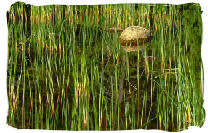 any of various tall grasses with slender often prominently jointed stems that grow especially in wet areas.
any of various tall grasses with slender often prominently jointed stems that grow especially in wet areas.
"From the back of Nar I could see the marsh, with its reeds and clouds of tiny flying insects below." — Tarnsman of Gor, page 84.
Rence On Earth, this plant is well-known as the Papyrus. On Gor, it is called Rence. A tufted, floral-spiked, reed-like plant that grows in the marshes. From the root, the rence plant can grow as much as sixteen feet and has an outgrowing, usually single floral spike. The rence plant has many uses, such as in the manufacture of paper, much like the papyrus of ancient Egypt. Too, from the very heavy and woody root, certain wooden tools and utensils can be carved from it, as well as making a good fuel when dried. The stem is used by the rence growers to make reed boats, sails, mats, cords and a kind of fibrous cloth. The pith, or center of the plant, is edible both raw and cooked, and is a staple in the diet of the rence growers is. The pith is also used, upon occasion, as a caulking for boat seams. Harvesting of the plant are generally cut during the summer months, but it is not unusual for harvesting to occur in the fall and even the winter months as well. Rence cut late in the year are stored in covered rence rafts until the spring, when it is used to weave mats and repair island surfaces, as well as using the pith for food. Rence knives, two inches in length, are used to harvest the reed.
Papyrus
"The writing material of ancient times and also the plant from which it was derived, Cyperus papyrus (family Cyperaceae), also called paper plant. The papyrus plant was long-cultivated in the Nile delta region in Egypt and was collected for its stalk or stem, whose central pith was cut into thin strips, pressed together, and dried to form a smooth, thin writing surface.
Papyrus is a grasslike aquatic plant that has woody, bluntly triangular stems and grows up to 4.6 m (about 15 feet) high in quietly flowing water up to 90 cm (3 feet) deep. The triangular stem can grow to a width of as much as 6 cm. The papyrus plant is now often used as a pool ornamental in warm areas or in conservatories. The dwarf papyrus (C. isocladus, also given as C. papyrus ‘Nanus'), up to 60 cm tall, is sometimes potted and grown indoors.
The ancient Egyptians used the stem of the papyrus plant to make sails, cloth, mats, cords, and, above all, paper. Paper made from papyrus was the chief writing material in ancient Egypt, was adopted by the Greeks, and was used extensively in the Roman Empire. It was used not only for the production of books (in roll or scroll form) but also for correspondence and legal documents. Pliny the Elder gave an account of the manufacture of paper from papyrus. The fibrous layers within the stem of the plant were removed, and a number of these longitudinal strips were placed side by side and then crossed at right angles with another set of strips. The two layers formed a sheet, which was then dampened and pressed. Upon drying, the gluelike sap of the plant acted as an adhesive and cemented the layers together. The sheet was finally hammered and dried in the sun. The paper thus formed was pure white in colour and, if well-made, was free of spots, stains, or other defects. A number of these sheets were then joined together with paste to form a roll, with usually not more than 20 sheets to a roll. Papyrus was cultivated and used for writing material by the Arabs of Egypt down to the time when the growing manufacture of paper from other plant fibres in the 8th and 9th centuries AD rendered papyrus unnecessary. By the 3rd century AD, papyrus had already begun to be replaced in Europe by the less-expensive vellum, or parchment, but the use of papyrus for books and documents persisted sporadically until about the 12th century." — Encyclopaedia Britannica ©2004-2006.
"It was difficult to see more than a few feet ahead." Sometimes I could see no further than the lifted prow of my small craft, as it nosed its way among the ruses and the frequent rence plants." — Raiders of Gor, page 1.
"On river barges, for hundreds of pasangs, I had made my way down the Vosk, but where the mighty Vosk began to break apart and spread into its hundreds of shallow, constantly shifting channels, becoming lost in the vast tidal marshes of its delta, moving toward gleaming Thassa, the Sea, I had abandoned the barges, purchasing from rence growers on the eastern periphery of the delta supplies and the small rush craft which I now propelled through the rushes and sedge, the wild rence plants." — Raiders of Gor, page 5.
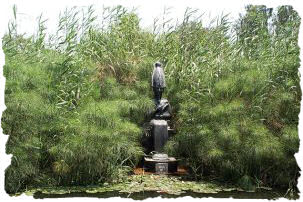 |
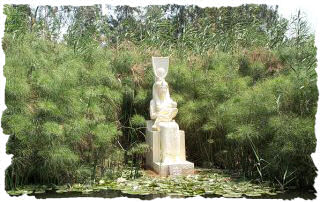 |
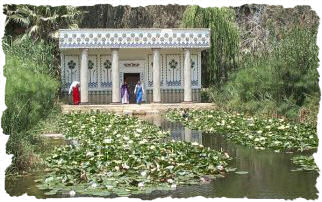 |
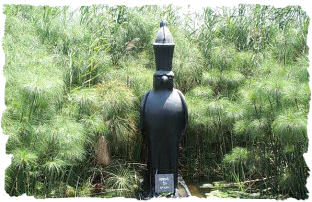 |
"A kind of paper is made from rence. The plant itself has a long, thick root, about four inches thick, which lies horizontally under the surface of the water; small roots sink downward into the mud from this main root, and several 'stems,' as many as a dozen, rise from it, often of the length of fifteen to sixteen feet from the root; it has an excrescent, usually single floral spike. The plant has many uses besides serving as a raw product in the manufacture of rence paper. The root, which is woody and heavy, is used for certain wooden tools and utensils, which can be carved from it; also, when dried, it makes a good fuel; from the stem the rence growers can make reed boats, sails, mats, cords and the kind of fibrous cloth; further, its pith is edible, and for the rence growers is, with fish, a staple in their diet; the pith is edible both raw and cooked; some men, lost in the delta, not knowing the pith edible, have died of starvation the midst of what was, had they known it, an almost endless abundance of food. The pith is also used, upon occasion, as a caulking for boat seams, but tow and pitch, covered with tar or grease, are generally used.
Rence paper is made by slicing the stem into thin, narrow strips; those near the center of the plant are particularly favored; one layer of strips is placed longitudinally, and then a shorter layer is placed latitudinally across the first layer; these two surfaces are then soaked under water, which releases a gluelike substance from the fibers, melding the two surfaces into a single, rectangular sheet; these formed sheets are then hammered and dried in the sun; roughness in removed by polishing, usually with a smooth shell or a bit of kailiauk horn; the side of a tharlarion tooth may also be used in this work. The paper is then attacked, sheet to sheet, to form rolls, usually about twenty sheets to a roll. The best paper is on the outside of the roll, always, not to practice deceit in the quality of the roll but rather to have the most durable paper on the outside, which will take the most weathering, handling and general wear. Rence paper comes in various grades, about eight in all. The rence growers market their product either at the eastern or western end of the delta. Sometimes rence merchants, on narrow marsh craft rowed by slaves, enter some pasangs into the delta to negotiate the transactions, usually from the western edge, that bordering the Tamber Gulf." — Raiders of Gor, pages 7-8."A woman left the group to bring some rence paste, and two men removed the marsh vine from my neck and ankles. My wrists were still bound behind my back. In a moment the woman had returned with a double handful of wet rence paste. When fried, on flat stones it makes a kind of cake, sprinkled with rence seeds." — Raiders of Gor, page 25.
In the stem of the girl's rence craft, she poling the craft from the stern, I knelt, cutting rence. It was late in the year to cut rence but some quantities of the rence are cut during the fall and winter and stored on covered rence rafts until spring. These stores of rence are not used for adding in the making of rence paper, but in the weaving of mats, for adding to the surface of the island, and for the pith, used as a food. "Cut there," said the girl, moving the rush craft into a thicket of rence. One holds the stem of the plant in the left hand and, with the right, with a small, curved, two-inch knife makes a diagonal upward stroke. — Raiders of Gor, page 27.
"The rence knife flashed through a stem and then I cut the tufted, flowered head, it falling in the water, and threw the stem on the rence craft, with the numerous others." — Raiders of Gor, page 30.
Rep
Rep itself is not a plant, but is, in actuality, a white fibrous matter which found in the seed pods of an unnamed, reddish, woody bush (most probably, the cotton plant).  The bush is commercially grown in many areas of Gor, but mostly in the area south of Ar and north of the equator belt; some is even grown in the Tahari, though most is imported. Rep-cloth is the by-product of this fibrous matter; cotton. The fiber itself is baled for transporting to be processed into the cloth, which is then sold in bolts. Rep-cloth is quite thin and clings well to curves of female body, used commonly for female slave garments, but also for turbans, robes, veils and tunics. Rep-cloth is also used for other items as well, such as blankets, pouches and sacks, and the outer curtains around the kurdah of the hot desert to keep the heat of the sun at bay.
The bush is commercially grown in many areas of Gor, but mostly in the area south of Ar and north of the equator belt; some is even grown in the Tahari, though most is imported. Rep-cloth is the by-product of this fibrous matter; cotton. The fiber itself is baled for transporting to be processed into the cloth, which is then sold in bolts. Rep-cloth is quite thin and clings well to curves of female body, used commonly for female slave garments, but also for turbans, robes, veils and tunics. Rep-cloth is also used for other items as well, such as blankets, pouches and sacks, and the outer curtains around the kurdah of the hot desert to keep the heat of the sun at bay.
"Rep is a whitish fibrous matter found in the seed pods of a small, reddish, woody bush, commercially grown in several areas, but particularly below Ar and above the equator; the cheap rep-cloth is woven in mills, commonly, in various cities; it takes dyes well and, being cheap and strong, is popular, particularly among the lower castes." — Raiders of Gor, pages 10-11.
"Some low-caste free women drank through their veils and there were yellow and purple stains on the rep-cloth." — Assassin of Gor, page 141.
"… polished, shell brooches; pins with heads carved from the horn of kailiauk tridents; lucky sleen teeth; racks of rep-cloth robes, veils and tunics in various caste colors …" — Assassin of Gor, page 156.
"Facing me, clean-shaven, but with a massive, regal face concealed in the hood of a peasant, his gigantic body broad and powerful in the coarse rep-cloth garment of what is thought to be Gor's lowest caste, there stood a man whom I could not mistake, even though it had been years since I had looked upon him, even though his great beard was now gone, even though his body now wore the hood and garment of a peasant." — Assassin of Gor, page 157.
"In these first voyages I was content, quite, to carry tools and stone, dried fruit, dried fish, bolts of rep-cloth, tem-wood, Tur-wood and Ka-la-na stock, and horn and hides." — Raiders of Gor, page 137.
"He wore a head scarf, the wrapped turban, wound about his head. It was of rep-cloth. It protects the head from the sun; its folds allow beat and perspiration to escape, evaporating, and, of course, air to enter and circulate. Among lower-class males, too, it provides a soft cushion, on which boxes, and other burdens, may be conveniently carried on the head, steadied by the right hand." — Tribesmen of Gor, page 36.
"Larma and tospits are also grown at the oases, in small orchards. Some rep is grown, for cloth, but most cloth comes to the oases from caravans." — Tribesmen of Gor, page 37.
"The girl, startled, cried out. She sat within, her knees to the left, her ankles together, her weight partly on her hands, to the right, on the small, silk-covered cushion of the frame. It was semicircular and about a yard in width at its widest point. The superstructure of the frame rose about four feet above the frame at its highest point, inclosing, as in an open-fronted, flat-bottomed, half globe, its occupant. This frame, however, was covered completely with layers of white rep cloth, to reflect the sun, with the exception of the front, which was closed with a center-opening curtain, also of white rep-sloth. The wood of the frame is tem-wood. It is light. It is carried by a pack kaiila, strapped to the beast, and steadied on both sides by braces against the pack blankets. This frame is called, in Gorean, the kurdah. It is used to transport women, either slave or free, in the Tahari. The girl was not chained within the kurdah. There is no need for it. The desert serves as cage." — Tribesmen of Gor, page 69.
"I drew from my garment a rag. It was thin, brief, tattered, much torn; it was cheap rep-cloth, brown and coarse; it was stained with dirt, with grease. I had found it in the kitchens of Ibn Saran." — Tribesmen of Gor, page 311.
"This was unusual, however, for normally the Gorean slave girl sleeps at the foot of her master's couch, often on a straw mat with only a thin, cottonlike blanket, woven from the soft fibers of the Rep Plant, to protect her from the cold." — Priest-Kings of Gor, page 67.
"I saw her eyes wild with fear for a moment above the rep-cloth veil and she had sped past me." — Nomads of Gor, page 1.
"Timidly Aphris rose and went to the thin rep-cloth blanket that was her bedding near the boots of Kamchak. Hidden in the blanket there was a faded yellow piece of cloth, which she had folded very small." — Nomads of Gor, page 151.
"I then noted that each of the four chief haruspexes carried, about his shoulder, a white linen sack, somewhat like a peasant's rep-cloth seed bag." — Nomads of Gor, page 172.
"My hair was concealed in the hood of a thin, ankle-length rep-cloth garment, a dirty white through which ran flecks of golden thread, a fit garment, in my opinion, for an insignificant merchant." — Nomads of Gor, page 234.
"Rep-cloth, commonly used in slave livery, is easily parted. The points of the spears had gone through the cloth, and she felt them in her flesh. She stepped back, for a moment frightened and disconcerted. Then she regained her composure, and stood before us." — Beasts of Gor, pages 22-23.
"Many Gorean masters, incidentally, shape and trim the hair of their own girls. This is less expensive than having it done in a pen. Too, it is pleasant to cut the hair of a girl one owns. She generally kneels, a wrap of rep-cloth about her shoulders, while this is done. Beneath the wrap of rep-cloth, of course, she is naked and in the position of a pleasure slave. When one is through with the cutting it is then convenient to have her." — Explorers of Gor, page 198.
"Most of the people seemed poor, fishermen, sawyers, porters, peasants. Most wore simple garments of plain wool, or even rep-cloth." — Marauders of Gor, page 33.
"The wool of the hurt is usually used for male slave garments; it absorbs perspiration well; and rep-cloth is commonly used for female slave garments; it is quite thin and clings well to the curves of the female body." — Fighting Slave of Gor, page 262.
I watched, a bale of rep fiber on my shoulder, near the rep wharf." — Rogue of Gor, page 153.
"I gave her some bread from my pack, from a rep-cloth draw-sack, and a bit of dried meat, paper thin, from its tied leather envelope." — Mercenaries of Gor, page 18.
"Leather is generally not permitted to slaves. Softer and more feminine fabrics, silk, rep-cloth, and such, often brief and clinging, not only stunningly attractive and aesthetically pleasing, but also indictive of, and reflective of, their subjection to masculine domination, are generally required of them." — Mercenaries of Gor, page 404.
Rushes
Tall, tubular reed-like plant found in marshlands, such as the Vosk delta. 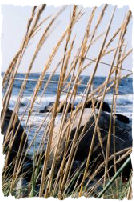
"A brightly plumaged bird sprang from the rushes to my left, screaming and beating its sudden way into the blue sky. In a moment it had darted again downward to be lost in the rushes, the waving spore stalks, the seed pods of various growths of the Gorean tidal marshes." — Raiders of Gor, page 1.
"I took the triangular-bladed tem-wood paddle and moved the small craft, light and narrow, large enough scarcely for one man, ahead. It was formed of pliant, tubular, lengthy Vosk rushes, bound with marsh vine." — Raiders of Gor, page 1.
Sa-Tarna Yellow grain, most probably wheat or wheatlike; most Sa-Tarna is grown in the north, including the Tahari, but it should also be noted that even Sa-Tarna fields were found even on the Turian Plains. In the Tahari, the grain is a golden brown color, the shell hardened to survive the desert winds. It is the staple of Gor, used to make flour (for bread, etc.) as well as brewing Paga. Most Sa-Tarna grain is commercially ground into flour at large mills using large querns, made of large stones, turned generally by water power, but also, at times, by male slaves, or tharlarion. Females cannot turn these large querns. In the smaller villages, a smaller version of the quern, somewhat akin to the mortar and pestle, is used, however, this type of quern is operated by men or boys, depending on the size of the quern. A smaller, hand-held quern in which a female can operate, uses a similar principal, but turned with a wooden handle.The grains are weighed on grain scales, and at market places, kept in huge grain baskets. Exported, the grains are placed in large grain sacks, bearing. Massive stores of grain in the larger cities, such as Ar, have grain cylinders. Migrating urts can often be problematic to fields.
"I set her down on a bed of green clover. Beyond it, some hundred yards away, I could see the border of a yellow field of Sa-Tarna and a yellow thicket of Ka-la-na trees." — Tarnsman of Gor, page 96.
The Older Tarl and I may have drunk too much of that fermented brew concocted with fiendish skill from the yellow grain, Sa-Tarna, and called Pagar Sa-Tarna, Pleasure of the Life-Daughter, but almost always 'Paga' for short. I doubted that I would ever touch the stuff again." — Tarnsman of Gor, page 61.
"Within the city the Initiates, who had seized control shortly after the flight of Marlenus, would have already tapped the siege reservoirs and begun to ration the stores of the huge grain cylinders. A city such as Ar, properly commanded, might withstand a siege for a generation." — Tarnsman of Gor, page 181.
"Men were now running from the palisade and the fields down to the dock. They were bare-headed, and wore shaggy jackets. Some wore trousers of skin, others tunics of dyed wool. I saw too, fields, fenced with rocks, in the sloping area. In them were growing, small at this season, shafts of Sa-Tarna…" — Marauders of Gor, page 81.
"The northern Sa-Tarna, in its rows, yellow and sprouting, was about ten inches high. The growing season at this latitude, mitigated by the Torvaldstream, was about one hundred and twenty days. This crop had actually been sown the preceding fall, a month following the harvest festival. It is sown early enough, however, that, before the deep frosts temporarily stop growth, a good root system can develop. Then, in the warmth of the spring, in the softening soil, the plants, hardy and rugged, again assert themselves. The yield of the fall-sown Sa-Tarna is, statistically, larger than that of the spring-sown varieties." — Marauders of Gor, page 102.
"At the oasis will be grown a hybrid, brownish Sa-Tarna, adapted to the heat of the desert; most Sa-Tarna is yellow; and beans, berries, onions tuber suls, various sorts of melons, a foliated leaf vegetable, called Katch, and various root vegetables, such as turnips, carrots, radishes, of the sphere and cylinder varieties, and korts, a large, brownish-skinned, thick-skinned, sphere-shaped vegetable, usually some six inches in width, the interior of which is yellowish, fibrous and heavily seeded." — Tribesmen of Gor, page 37.
"But now I could hear, carried on the wind blowing toward distant Turia, the bellowing of the bosks. The dust was now heavy like nightfall in the air. The grass and the earth seemed to quake beneath my tread. I passed fields that were burning, and burning huts of peasants, the smoking shells of Sa-Tarna granaries, the shattered, slatted coops for vulos, the broken walls of keeps for the small, longhaired domestic verr, less belligerent and sizeable than the wild verr of the Voltai Ranges." — Nomads of Gor, page 10.
"Most Sa-Tarna is now ground in mills, between stones, the top stone usually turned by water power, but sometimes by a tharlarion, or slaves." — Renegades of Gor, page 17.
"Five days ago I had been returning to the camp of Boots Tarsk-Bit, coming back from a nearby village where I had gone to fetch Sa-Tarna grain, from which the girls, back at the camp, using stones and flat rocks, sifters and pans, would produce flour. This was somewhat cheaper than buying the flour directly, for then one must pay the cost of the peasant women's work or that of its millage. I carried the sack across my shoulders. It was not heavy. It weighed only a little more than an average female." — Players of Gor, page 258.
been dispelled by the thick, black, stenciled lettering on the bag, giving a bold and unmistakable account of its earlier contents, together with their grind and grade, and the signs of the processing mill and its associated wholesaler." — Players of Gor, page 216.
"I passed a fellow inlaying wood, and the shop of a silversmith, and stalls filled with baskets, some of which, grain baskets, were large enough to hold a man." — Tribesmen of Gor, page 50.
She had even been thrown on a grain scale and weighed." — Explorers of Gor, page 66.
"Certain species of urts migrate twice a year. At such times, annually, it is usually necessary only to avoid them. People usually remain indoors when a pack is in their vicinity. There is little danger from these migrations unless one finds oneself in their direct path. The urt, on the whole, most species of which are quite small, large enough to be lifted in one hand, does not pose much direct threat to human beings. They can destroy Sa-Tarna fields and force their way into granaries." — Players of Gor, page 184.
Seaweed
In times of hunger, men of the seas often chew on these plants of the sea. Some seaweeds are poisonous to man.
"There is often not enough food under any conditions, particularly in northern Torvaldsland, and famine is not known. In such cases men feed on bark, and lichens and seaweed." — Marauders of Gor, page 55.
"Many fish in these tropical waters are poisonous to eat, a function of certain forms of seaweed on which they feed. The seaweed is harmless to the fish but it contains substances toxic to humans." — Explorers of Gor, page 109.
Sedge A plant found along rivers and marshes. Papyrus (rence) is a form of sedge. Sedge meadows are the result of flooding. They are most easily found in early spring. Areas that are low-lying and flat near rivers and streams will accumulate with a few inches of water. The rest of the year, sedge meadows rarely have standing water. Sedge meadows are most successful when the soil remains saturated most of the time. This allows for the abundant growth of a kind of grass called a sedge. The Egyptians used a special kind of sedge called papyrus to make paper. The soil in sedge meadow is formed from the decomposition of sedges like the Carex stricta. When a sedge grows it forms a symmetrical lump or hummock in the water. The soil between the tussocks of Carex stricta is peat that was created by the decay of the underground roots and stems of this plant. When peat dries out, it burns easily. As a matter of fact, peat is used in some countries as a form of fuel. Fires are a natural occurrence in a sedge meadow. In years of drought, fires will clean out the sedge meadow of invading woody plants.
Etymology: Middle English segge, from Old English secg; akin to Middle High German segge sedge, Old English sagu, sage saw;
1a: a plant of the family Cyperaceae and especially of the genus Carex; b: Sweet Flag; c: Yellow Iris." — Merriam-Webster Dictionary ©2004-2006.
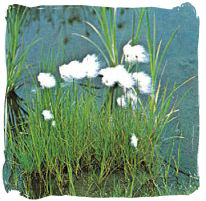 |
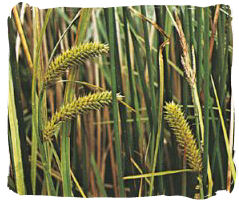 |
| Cotton Grass (Eriophorum) | Sedge (Carex vesicaria) |
Common name for members of the Cyperaceae, a family of grasslike and rushlike herbs found in all parts of the world, especially in marshes of subarctic and temperate zones. The name sedge is also used specifically for species of the genus Carex of the same family. Sedges differ from true grasses in having solid, angular (usually triangular) stems. Most are perennial, reproducing by rhizomes. Some sedges are woven into mats and chair seats, and a few provide coarse hay. The pith of Cyperus papyrus was the source of the papyrus of ancient Egypt and other Mediterranean countries. Bulrushes, often called clubrushes, are sedges of the genus Scirpus; various other similar plants are also called bulrushes. The bulrushes in which the infant Moses was hidden (Ex. 2.8) were probably papyrus. The Oriental water chestnut ( Eleocharis tuberosa ) is cultivated extensively among the Chinese for its edible tubers. An unrelated Asian aquatic plant, Trapa natans, also called water chestnut (or water caltrop or hornnut) and sometimes also used for food, is now naturalized in the United States. Many genera of the sedge family have indigenous and abundant species in America. Sedge is classified in the division Magnoliophyta., class Liliopsida, order Cyperales, family Cyperaceae." — Columbia Encyclopedia, Sixth Edition, Copyright (©) 2004.
Sweet Sedge: Synonyms: Calamus. Sweet Flag. Sweet Root. Sweet Rush. Sweet Cane. Gladdon. Sweet Myrtle. Myrtle Grass. Myrtle Sedge. Cinnamon Sedge.
Part Used: Root.
Habitat: Found in all European countries except Spain. Southern Russia, northern Asia Minor, southern Siberia, China, Japan, northern United States of America, Hungary, Burma, Ceylon and India.
The Sweet Sedge is a vigorous, reed-like, aquatic plant, flourishing in ditches, by the margins of lakes and streams and in marshy places generally, associated with reeds, bullrushes and bur-reed. Its erect, sword-shaped leaves bear considerable resemblance to those of the Yellow Flag, hence its equally common popular name of 'Sweet Flag,' though it is not related botanically to the Iris, being a member of the Arum order, Araceae. All parts of the plant have a peculiar, agreeable fragrance. Formerly, on account of its pleasant odour, it was freely strewn on the floors of churches at festivals and often in private houses, instead of rushes. The specific name, calamus, is derived from the Greek calamos (a reed). The floors of Norwich Cathedral until quite recently were always strewn with calamus at great festivals. The rhizomes are gathered when large enough, generally after two or three years, and before they lose their firmness and become hollow. Late autumn or early spring is the time chosen for collection. If actually growing in water, the raft-like masses of interwoven roots and mud, which in a river or lake float about a foot below the surface of the water, are cut out in square sections, raked to the lake edge, the leaves stripped off and separated. Whether growing thus actually in water, or in moist ground, the rhizomes are next thoroughly washed in a trough, and then, deprived of the far less aromatic and brittle rootlets, which are 4 to 6 inches long, unbranched, but near the tip beset with soft, thin fibres. The fresh root-stock is brownish-red, or greenish-white and reddish within and of a spongy texture, tolerably uniform in transverse section. It has an aromatic sweet odor and a bitterish, pungent taste.
Various Members of the Sedge Family Umbrella Plant (Cyperus alternifolius) Bulrush (Scirpus palustris) Other Sedges:
The Sedge family is of comparatively slight economic importance. The plants are distinguished from the true Grasses, which they closely resemble, by their solid stems, leafsheaths which are not connate, and the presence of but a single scale to each flower. They are mostly coarse, harsh and indigestible, and not adapted for food purposes, though the rhizomes of several have been utilized as starchy foods. Quite a number possess volatile oils and aromatic principles, while others are rich in astringents — chiefly the species indigenous to India and China.
Among the more important aromatics and carminatives are Cyperus sanguinea-fuscus (Nees), the Cure-pire of Paraguay, C. elegans (Rottb.) of Mexico; C. pertenuis (Roxb.), the Indian Nagar-motha or Koriak, whose roots, when dried and powdered, are used by the Indian ladies for perfuming their hair; and C. tegetum (Roxb.); Adrue or Guinea Rush is the rhizome of C. articulatus (Linn.), which, besides being used as a carminative, has a high repute in the East Indies for anti-emetic properties. The blackish tubers have a somewhat bitter, aromatic taste, resembling that of Lavender. A fluid extract is prepared from them used in herbal medicine. The aromatic properties of the drug cause a feeling of warmth to be diffused throughout the system and act as a sedative in dyspeptic disorders. It is common also in Jamaica and on the banks of the Nile.
C. Papyrus is the Egyptian Papyrus, the fibrous stems of which provided the earliest form of paper known. This plant had various economic uses, as Pliny and other writers have shown, though as the Egyptians cultivated other Sedges, it is probable that these became more exclusively used for food and fuel, sails and cordage, baskets and sieves, not to speak of punts or canoes to which the prophet Isaiah refers (Isaiah xviii. 2), where the Ethiopians are spoken of as sending ambassadors by the sea even in vessels of bulrushes upon the waters (the Hebrew word is gome). The papyrus was, in ancient times, carefully cultivated, especially in certain districts of Lower, and probably of Upper Egypt also, for the great and important purpose with which its name must ever be associated.
Uses:
Calamus Oil, a derivitive of papyrus, is used in perfumery — an alcoholate is made with 3 kilos to 3.5 kilos of rhizome to 20 litres of 85 per cent alcohol. The oil is strong and fragrant, its taste warm, bitterish, pungent and aromatic. Its active principles are taken up by boiling water. It is a thick, pale yellow liquid. Little is known of its chemistry, though it possibly contains pinene and the chief aromatic constituent is asaryl aldehyde. The powdered root is also esteemed in Ceylon and India as a vermifuge and an insecticide, especially in relation to fleas. Sprinkled round a tree attacked by white ants in Malay (Perak) it was found to destroy those that were near the surface and prevented others from attacking the tree. In powder, Calamus root on account of its spicy flavor serves as a substitute for cinnamon, nutmeg and ginger. It is said also to be used by snuff manufacturers and to scent hair-powders and in tooth-powders, in the same way as orris. The oil is used by rectifiers to improve the flavor of gin and to give a peculiar taste and fragrance to certain varieties of beer. In the United States, Calamus was also formerly used by country people as an ingredient in making wine bitters." — from: http://www.botanical.com/
"It was late in the afternoon, the fourteenth Gorean Ahn I would have guessed. Some swarms of insects hung in the sedge here and there but I had not been much bothered: it was late in the year, and most of the Gorean insects likely to make life miserable for men bred in, and frequented, areas in which bodies of unmoving, fresh water were plentiful." — Raiders of Gor, page 5.
Sim Plant A rambling, tangled vine-like plant with huge, rolling leaves, raised in the pasture chambers of the Nest of the Priest-Kings.
"I did not know at the time but Gur is a product originally secreted by large, grey, domesticated, hemispheric arthropods which are, in the morning, taken out to pasture where they feed on special Sim plants, extensive, rambling, tangled vine-like plants with huge, rolling leaves raised under square energy lamps fixed in the ceilings of the broad pasture chambers, and at night are returned to their stable cells where they are milked by Muls." — Priest-Kings of Gor, page 214.
Sip Root A bitter root whose extract is the active ingredient in slavewine.
"Unless you have had slave wine," he said, "I have no intention of taking you through the streets clad as you are. Suppose you are raped."
I put the flask, which he had opened, to my lips. Its opening was large enough to drink freely from. "It is bitter!" I said, touching my lips to it.
"It is the standard concentration, and dosage," he said, "plus a little more, for assurance. Its effect is indefinite, but it is normally renewed annually, primarily for symbolic purposes.
I could not believe how bitter it was. I had learned from Susan, whom I had once questioned on the matter, the object. It is prepared from a derivative of sip root. The formula, too, I had learned, at the insistence of masters and slavers, had been improved by the caste of physicians within the last few years. It was now, for most practical purposes, universally effective. Too, as Drusus Rencius had mentioned, its effects, at least for most practical purposes, lasted indefinitely. — Kajira of Gor, pages 130-131."We make them chew carefully and watch closely to see that they swallow, bit by bit, in small swallows, sip roots, as well," said another.
"We then examine their mouths, forcing them widely open, to determine that they have finished their entire allotment of the root," said another.
I nodded. Sip roots are extremely bitter. Slave wine, incidentally, is made from sip roots. The slaves of the red savages, like slaves generally on Gor, would be crossed and bred only as, and precisely as, their masters might choose. — Blood Brothers of Gor, pages 124-125.I held the object before her. She regarded it with dismay. "I have already chewed sip root within the moon," she said. "Open your mouth," I said.
"Yes, Master," she said. I then thrust the object into her mouth.
"Chew it well," I said, "and swallow it, bit by bit." She grimaced, at the barest taste of the object. "Begin," I told her. She began. "Not so quickly," I told her. "More slowly. Very slowly. Very, very slowly. Savor it well." She whimpered in obedience.
She did not need the sip root, of course, for, as she had pointed out, she had had some within the moon, and, indeed, the effect of sip root, in the raw state, in most women, is three or four moons. In the concentrated state, as in slave wine, developed by the caste of physicians, the effect is almost indefinite, usually requiring a releaser for its remission, usually administered to a slave, in what is called the breeding wine, or the "second wine." When this is administered she usually knows that she has been selected for crossing with a handsome male slave.
Such breedings commonly take place with the slaves hooded, and under the supervision of the master, or masters. In this way the occurrence of the breeding act can be confirmed and authenticated. Sometimes a member of the caste of scribes is also present, to provide certification on behalf of the city. Usually, however, in cities which encourage this sort of registration it is sufficient to bring the papers for stamping to the proper office within forty Ahn. Such rigor, however, is usually involved only in the breeding of expensive, pedigreed slaves. Most slave breeding is at the discretion of the private master or masters involved. Slaves from the same household, incidentally, are seldom mated. This practice is intended to reduce the likelihood of intimate emotional relationships among slaves. Furthermore, male and female slaves are usually kept separate, female slaves commonly performing light labors in households and male slaves working in the fields or on the grounds. Sometimes, to reward male slaves, or keep them content, or even to keep them from going insane, a female slave is thrown to them. This is sometimes a girl of delicate sensibilities from the house who has not been perfectly pleasing; she then finds herself thrown naked to work slaves. In slave matings, since most crossings do not take place within the same household, a stud fee is usually paid to the master of the male slave. The active ingredient in the breeding wine, or the "second wine," is a derivative of teslki. In the matter of bitterness of taste there is little to choose from between raw sip root and slave wine, the emulsive qualities of the slave wine being offset to some extent by the strength of the concentrations involved. — Blood Brothers of Gor, pages 319-320.
Spikenard
A perennial; export from the Bazi region; an herb used in healing for salves.
Spikenard is a aromatic rhizome. The botanical name has its roots in the Hindu word Jatamansi which means "lock of hair." It's use goes back in several cultures and religions. Medically it's part of the Ayurveda, and is traditionally considered to calm the nerves and promote awareness and strengthen the mind. It is in the same family as Valeriana jatamansi (Indian valerian) and was sometimes used treatment of hysteria. 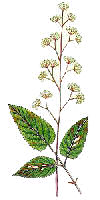 Spikenard is one of the most common ingredients in ancient Japanese incense recipes. One of the most famous references to Spikenard comes in the Christian New Testament, book of John, chapter 12:
Spikenard is one of the most common ingredients in ancient Japanese incense recipes. One of the most famous references to Spikenard comes in the Christian New Testament, book of John, chapter 12:
Then Jesus six days before the passover came to Bethany, where Lazarus was which had been dead, whom he raised from the dead.There they made him a supper; and Martha served: but Lazarus was one of them that sat at the table with him. Then took Mary a pound of ointment of spikenard, very costly, and anointed the feet of Jesus, and wiped his feet with her hair: and the house was filled with the odour of the ointment. Then saith one of his disciples, Judas Iscariot, Simon's son, which should betray him, "Why was not this ointment sold for three hundred pence, and given to the poor?" This he said, not that he cared for the poor; but because he was a thief, and had the bag, and bare what was put therein. Then said Jesus, "Let her alone: against the day of my burying hath she kept this. For the poor always ye have with you; but me ye have not always."
Etymology: Middle English, from Middle French or Medieval Latin; Middle French spicanarde, from Medieval Latin spica nardi (translation of Greek nardou stachys), from Latin spica head (of grain), tuft (of a plant) + nardi, gen. of nardus nard;
"1a: a costly ointment with a musky odor valued as a perfume in ancient times — called also nard; b: an East Indian aromatic plant (Nardostachys jatamansi) of the family Valerianaceae from the dried roots and young stems of which the ointment spikenard is believed to have been derived
2a: an American herb (Aralia racemosa) distinguished from wild sarsaparilla by its more aromatic root and its panicled umbels — called also American spikenard; b: any of various other fragrant plants — usually used in combination, i.e., plowman's-spikenard." — Merriam-Webster Dictionary ©2004-2006.Spikenard (Aralia racemosa) is a perennial that can reach 10 feet tall. It prefers rich humus soils, partial to full shade, and is commonly found wild in woods and thickets. Spikenard is used to shorten labor and to ease childbirth, reduces uric acid, and is often used in cough syrups.
— Encyclopedia of Herbs ©2004
"There is a little market in simple Laura for the more exquisite goods of Gor. Seldom will one find there Torian rolls of gold wire, interlocking cubes of silver from Tharna, rubies carved into tiny, burning panthers from Schendi, nutmegs and cloves, spikenard and peppers from the lands east of Bazi, the floral brocades, the perfumes of Tyros, the dark wines, the gorgeous diaphanous silks of glorious Ar. Life, even by Gorean standards, is primitive in the region of the Laurius, and northward, to the great forests, and along the coast, upward to Torvaldsland." — Captive of Gor, page 86.
Squash
Vegetable grown in agricultural communities in the Barrens. 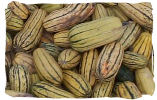
Etymology: by shortening & alteration from earlier is quoutersquash, from Natick & Narragansett askútasquash, literally, green thing eaten green;
"Any of various fruits of plants of the genus Cucurbita that are widely cultivated as a vegetable and for livestock feed: such as a summer squash, winter squash, pumpkin; or squash vine: a plant that bears squashes."
— Merriam-Webster Dictionary ©2004-2006.
"They grow produce for their masters, such as wagmeza and wagmu, maize, or corn, and such things as pumpkins and squash." — Savages of Gor, page 234.
Suls
Starchy, golden brown, vine borne vegetable; principal ingredient in Sullage, a tuberous vegetable, possibly similar to the sweet potato. Or perhaps this is the potato that Norman speaks of later? See "Potato."
"The principal ingredients of Sullage are the golden Sul, the starchy, golden-brown vine-borne fruit of the golden-leaved Sul plant; the curled, red, ovate leaves of the Tur-Pah, a tree parasite, cultivated in host orchards of Tur trees; and the salty, blue secondary roots of the Kes Shrub, a small, deeply rooted plant which grows best in sandy soil." — Priest-Kings of Gor, pages 44-45.
"…the food, bosk steak and yellow bread, peas and Torian olives, and two golden-brown, starchy Suls, broken open and filled with melted bosk cheese." — Assassin of Gor page 168.
"The Sul is a large, thick-skinned, yellow-fleshed, root vegetable. It is very common on this world. There are a thousand ways in which it is prepared. It is fed even to slaves. I had had some at the house; narrow, cooked slices, smeared with butter, sprinkled with salt, fed to me by hand." — Dancer of Gor, page 80.
"Telima had prepared a roast tarsk, stuffed with suls and peppers from Tor." — Raiders of Gor, page 114.
"The slave boy, Fish, had emerged from the kitchen, holding over his head on a large silver platter a whole roasted tarsk, steaming and crisped, basted, shining under the torchlight, a larma in its mouth, garnished with suls and Tur-pah." — Raiders of Gor, page 219.
"The Sul is a tuberous root of the Sul plant; it is a Gorean staple." — Slave Girl of Gor, page 134.
"I cut at the soil with the hoe, chopping and loosening the dirt about the roots of the sul plant." — Slave Girl of Gor, page 190.
"Soup!" I called, raising my hand. I purchased from him, for a copper tarsk, a bowl of soup, thick with shreds of hot bosk and porous chunks of boiled sul." — Beasts of Gor, page 51.
"I saw too, fields, fenced with rocks, in the sloping area. In them were growing, small at this season, shafts of Sa-Tarna; too, there would be peas, and beans, cabbages and onions, and patches of the golden sul, capable of surviving at this latitude." — Marauders of Gor, page 81.
"On the way back to the hall, cutting through the tospit trees, we had passed by the sul patch." — Marauders of Gor, page 103.
"A great amount of farming, or perhaps one should speak of gardening, is done at the oasis, but little of this is exported. At the oasis will be grown a hybrid, brownish Sa-Tarna, adapted to the heat of the desert; most Sa-Tarna is yellow; and beans, berries, onions, tuber suls, various sorts of melons, a foliated leaf vegetable, called Katch, and various root vegetables, such as turnips, carrots, radishes, of the sphere and cylinder varieties, and korts, a large, brownish-skinned, thick-skinned, sphere-shaped vegetable, usually some six inches in width, the interior of which is yellowish, fibrous and heavily seeded. At the oasis, because of the warm climate, the farmers can grow two or more crops a year." — Tribesmen of Gor, page 37.
Swamp Trees
A tree indigenous to the swamps and marshes of Gor;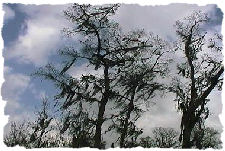 can grow so thickly together, they form a forest of sorts. Pictured here are swamp trees of Florida.
can grow so thickly together, they form a forest of sorts. Pictured here are swamp trees of Florida.
"Without thinking, I leaped from the back of Nar, seizing one of the long, tendril-like vines that parasitically interlace the gnarled forms of the swamp trees." — Tarnsman of Gor, page 85.
"The third day's camp was made in the swamp forest that borders the city of Ar on the north." — Tarnsman of Gor, page 74.
Swamp Vine
Vines found in the swamplands. See: "Marsh Vine."
"Without thinking, I leaped from the back of Nar, seizing one of the long, tendril-like vines that parasitically interlace the gnarled forms of the swamp trees." — Tarnsman of Gor, page 85.
Ta Grapes
These grapes hail from the isle of Cos and resemble grapes of Earth. They are used in making Ta wine, but are also a favored fruit to eat.
"The meal was completed by a handful of grapes and a draught of water from the wall tap. The grapes were purple and, I suppose, Ta grapes from the lower vineyards of the terraced island of Cos some four hundred pasangs from Port Kar… If they were indeed Ta grapes I supposed they must have come by galley from Cos to Port Kar, and from Port Kar to the Fair of En'Kara. Port Kar and Cos are hereditary enemies, but such traditions would not be likely to preclude some profitable smuggling." — Priest-Kings of Gor, page 45.
"… or the vineyards where the Ta grapes are raised…" — Nomads of Gor, page 35.
"Cos is also a lofty island, even loftier than Tyros, but she has level fields to her west. Cos had many terraces, on which the Ta grapes are grown." — Raiders of Gor, page 139.
"One girl held back our head, and others, from goblets, gave us of wines, Turian wine, sweet and thick, Ta wine, from the famed Ta grapes, from the terraces of Cos, wines even, Ka-la-nas, sweets and drys, from distant Ar." — Tribesmen of Gor, page 213.
"He was veiled, in the manner of the Char, as were the others with him. He picked a grape from a bowl of fruit on a small table near him, and, holding the veil from his face, as do the men of the Char, put the bit of fruit into his mouth, and bit into it. It was pitted. He chewed on the fruit." — Tribesmen of Gor, page 211.
Talender A delicate, yellow-petaled meadow flower, symbolic of feminine love and beauty; a crown of talendars is often worn by a free woman during the Companionship ceremony; worn in a slave girl's hair, it is sign that she holds great love her Master.
I took two talenders which had fallen on my shoulder and fastened them in the ropes at her neck. This delighted the crowds, who cried out their pleasure.
"No," she begged. "Not talenders."
"Yes," said I, "talenders."
The talender is a flower which, in the Gorean mind, is associated with beauty and passion. Free Companions, on the Feast of their Free Companionship, commonly wear a garland of talenders. Sometimes slave girls, having been subdued, but fearing to speak, will fix talenders in their hair, that their master may know that they have at last surrendered themselves to him as helpless love slaves. To put talenders in the neck ropes of the girl at the prow, of course, was only mockery, indicative of her probable disposition as pleasure slave. — Raiders of Gor, pages 216-217.
Telekint A plant of the Tahari; its roots, mashed and mixed with water, provide a red dye.
"The rep-cloth veil was red; it had been soaked in a primitive dye, mixed from water and the mashed roots of the telekint; when he perspired, it had run; his face was stained. He thrust back the sleeve of his trail shirt." — Tribesmen of Gor, page 83.
Tem A black-wooded tree which is very strong and used in building materials and considered fine arrowwood. The wood is also used in the building of ship rudders and oars.
"In these first voyages I was content, quite, to carry tools and stone, dried fruit, dried fish, bolts of rep-cloth, tem-wood, Tur-wood and Ka-la-na stock, and horn and hides." — Raiders of Gor, page 138.
"Port Kar is, incidentally, completely dependent on the northern timber. Tur wood is used for galley frames, and beams and clamps and posts, and for hull planking; Ka-la-na serves for capstans and mastheads; Tem-wood for rudders and oars; and the needle trees, the evergreens, for masts and spars, and cabin and deck planking." — Raiders of Gor, page 141.
Teriotrope
A plant bearing fragrant flowers.
"I looked upwards, and about the room. The multicolored ribbons were festive; the lamps were lovely; and the flowers, abundant and colorful, mostly larma blossoms, veminia and teriotrope, were beautiful and fragrant. Lola had done well." — Guardsman of Gor, page 240.
Tes
A shrub. Nothing is given as far as information on this shrub. Could it be teslik? See: "Teslik."
"What sort of shrubbery?" I asked.
"Some festal," he said, "some tes, a bit of tor." — Vagabonds of Gor, page 339.
Teslik
A plant whose extract is the active ingredient in breeding wine. Reference is made to a shrub spoken of only as "Tes;" could they be one and the same? See: "Tes."
"The active ingredient in the breeding wine, or the 'second wine,' is a derivative of teslik." — Blood Brothers of Gor, page 320.
Thorn-Brush
Thick thorny brush which grows heavily together, forming "walls" and are often used as natural fencing.
I turned to the wall of thorn brush. I feared it. It was high and thick. The guard was not watching. The camp was not his concern. His concern was elsewhere, with possible approaches to the camp, the fields beyond the valleys. I cried out with misery. I screamed, frightened. The brush sank beneath me. It would not support my weight. My right leg was deep in it, my right arm. I turned my head to the side, keeping my eyes closed. I felt the thorns. They seemed to tear at me. I was half immersed in the brush. I was caught. I dared not move. I began to weep and scream. My master was first to my side. He was not much pleased. I immediately fell silent. Another man came, bearing a torch, lit from the stirred ashes of the fire. Some other men arose but then, seeing it was only a slave girl, returned to their furs and tenting. Eta hurried over to me, but a curt word from my master hurried her back to her rest with dispatch. "I'm caught, Master," I whimpered. Only too obviously had I been trying to escape. In the torchlight he pulled my head back, by the hair, to clear it of the thorns. He did not want me blinded. I managed, suffering long scratches, to extricate my right arm. He looked at me. I was afraid he was going to leave me as I was. I could not pull my right leg back because of its position in the brush. I had no leverage, as I stood, to lift my leg out. "Please help me, Master," I begged. I had no wish to remain caught in the thorn brush until morning. It was embarrassing, and I was helpless, and it was painful. "Please, Master," I begged, "help me." — Slave Girl of Gor, pages 95-96.
"My master, with a spear and a loop of rope, under the torchlight, the torch held by one of his men, opened a passage in the thorn bush. I looked with dread down the narrow corridor forced between the walls of fierce thorn brush, into the darkness beyond." — Slave Girl of Gor, pages 98-99.
Tor Shrub
Translated, the name means "shrub of light" or "bright shrub" because of its many bright flowers of either white or yellow, depending on the variety; it flowers in the fall. The shrub has many names (which are not provided in the books) but one of the more common names is the Tor Shrub). The shrub grows only as high as a man's waist.
"What sort of shrubbery?" I asked.
"Some festal," he said, "some tes, a bit of tor."
"You are sure it is a tor shrub?" I asked.
He looked. "Yes," he said.
"I, too, think it is a tor shrub," I said. The shrub has various names, but one of them is the tor shrub, which name might be fairly translated, I would think, as, say, the bright shrub, or the shrub of light, it having that name. I suppose, because of its abundant, bright flowers, either yellow or white, depending on the variety. It is a very lovely shrub in bloom. It was not in bloom now, of course, as it flowers in the fall. …
"The tor shrub," I said, "does not grow higher than a man's waist." — Vagabonds of Gor, pages 339-340.
Tospit Bush A bush which produces the tospit fruit. Okay. So which is it that bears the tospit fruit — a Tospit Bush or a Tospit Tree? It would seem that John Norman made an error. The answer to this question is that the tospit comes in two (2) varieties: the rare, long-stemmed variety, which grows on the tospit bush, indigenous to the dry valleys of the western Cartius, and the common tospit, which grows on tospit trees and are often grown commercially in orchards.
"… I raced past a wooden wand fixed in the earth, on the top of which was placed a dried tospit, a small, wrinkled, yellowish-white peachlike fruit, about the size of a plum, which grows on the tospit bush, patches of which are indigenous to the drier valleys of the western Cartius. They are bitter but edible." — Nomads of Gor, page 59.
Tospit Tree A tree which produces the tospit fruit. Okay. So which is it that bears the tospit fruit — a Tospit Bush or a Tospit Tree? It would seem that John Norman made an error. The answer to this question is that the tospit comes in two (2) varieties: the rare, long-stemmed variety, which grows on the tospit bush, indigenous to the dry valleys of the western Cartius, and the common tospit, which grows on tospit trees and are often grown commercially in orchards.
"The tospits, in the Forkbeard's orchard, which can grow at this latitude, as the larma cannot, were too green to eat. I smiled, ecalling that tospits almost invariably have an odd number of seeds, saving the rarer, long-stemmed variety. I do not care too much for tospits, as they are quite bitter. Some men like them. They are commonly used, sliced and sweetened with honey, and in syrups, and to flavor, with their juices, a variety of dishes. They are also excellent in the prevention of nutritional deficiencies at sea, in long voyages, containing, I expect, a great deal of vitamin C. They are sometimes called the seaman's larma. They are a fairly hardfleshed fruit, and are not difficult to dry and store. On the serpents they are carried in small barrels, usually kept, with vegetables, under the overturned keel of the longboat." — Marauders of Gor, page 102.
"On the way back to the hall, cutting through the tospit trees, we had passed by the sul patch." — Marauders of Gor, page 103.
"A great amount of farming, or perhaps one should speak of gardening, is done at the oasis, but little of this is exported… Larma and tospits are also grown at the oases, in small orchards." — Tribesmen of Gor, page 37.
"A boy passed, spitting out the seeds of a tospit. On the Plains of Turia, or in the Land of the Wagon People, it was available only late in the summer. Here, in Tor, however, with its two growing seasons, they might be available much earlier." — Tribesmen of Gor, pages 45-46.
Tur
A tall, reddish tree having a large trunk, indigent to the northern forests. 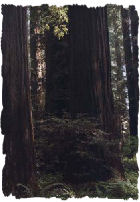 The Redwoods of Gor. The wood of the Tur is used in the building of ship frames, beams, posts, clamps, and the planking for the hulls. Apparently, at one point, a lone Tur grew on the southern plains, the city of Turia taking its name from that lone tree.
The Redwoods of Gor. The wood of the Tur is used in the building of ship frames, beams, posts, clamps, and the planking for the hulls. Apparently, at one point, a lone Tur grew on the southern plains, the city of Turia taking its name from that lone tree.
"Port Kar is, incidentally, completely dependent on the northern timber. Tur wood is used for galley frames, and beams and clamps and posts, and for hull planking; Ka-la-na serves for capstans and mastheads; Tem-wood for rudders and oars; and the needle trees, the evergreens, for masts and spars, and cabin and deck planking." — Raiders of Gor, page 141.
"In these first voyages I was content, quite, to carry tools and stone, dried fruit, dried fish, bolts of rep-cloth, tem-wood, Tur-wood and Ka-la-na stock, and horn and hides." — Raiders of Gor, page 138.
"And so we sat with our backs against the flower tree in the House of Saphrar, merchant of Turia. I looked at the lovely, dangling loops of interwoven blossoms which hung from the curved branches of the tree. I knew that the clusters of flowers which, cluster upon cluster, graced those linear, hanging stems, would each be a bouquet in itself, for the trees are so bred that the clustered flowers emerge in subtle, delicate patterns of shades and hues. Besides several of the flower trees there were also some Ka-la-na trees, or the yellow wine trees of Gor; there was one large-bunked, reddish Tur tree, about which curled its assemblage of Tur-Pah, a vinelike tree parasite with curled, scarlet, ovate leaves, rather lovely to look upon; the leaves of the Tur-Pah incidentally are edible and figure in certain Gorean dishes, such as sullage, a kind of soup; long ago, I had heard, a Tur tree was found on the prairie, near a spring, planted perhaps long before by someone who passed by; it was from that Tur tree that the city of Turia took its name; there was also, at one side of the garden, against the far wall, a grove of tem-wood, linear, black, supple." — Nomads of Gor, page 217.
Turnips
A sharp-tasting root vegetable; good for stews. 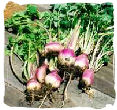
"…who tumbled onions, turnips, radishes, potatoes and bread into the feed trough. — Outlaw of Gor, page 155.
"I have peas and turnips, garlic and onions in my hut." — Outlaw of Gor, page 29.
"A great amount of farming, or perhaps one should speak of gardening, is done at the oasis, but little of this is exported. At the oasis will be grown a hybrid, brownish Sa-Tarna, adapted to the heat of the desert; most Sa-Tarna is yellow; and beans, berries, onions, tuber suls, various sorts of melons, a foliated leaf vegetable, called Katch, and various root vegetables, such as turnips, carrots, radishes, of the sphere and cylinder varieties, and korts, a large, brownish-skinned, thick-skinned, sphere-shaped vegetable, usually some six inches in width, the interior of which is yellowish, fibrous and heavily seeded. At the oasis, because of the warm climate, the farmers can grow two or more crops a year." — Tribesmen of Gor, page 37.
Tur-Pah
A vine-like plant, with curled scarlet ovate leaves, which grows parasitically on the Tur trees. 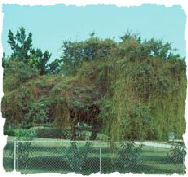 This plant is edible, and an ingredient in sullage, a type of soup. Pictured here: Devil's Gut (Cassytha filiformia). Devil's Gut is a commonly seen parasitic vine of the tropics, here occurring on a shrub in the Hawaiian Islands.
This plant is edible, and an ingredient in sullage, a type of soup. Pictured here: Devil's Gut (Cassytha filiformia). Devil's Gut is a commonly seen parasitic vine of the tropics, here occurring on a shrub in the Hawaiian Islands.
"Besides several of the flower trees there were also some Ka-la-na trees, or the yellow wine trees of Gor; there was one large-bunked, reddish Tur tree, about which curled its assemblage of Tur-Pah, a vinelike tree parasite with curled, scarlet, ovate leaves, rather lovely to look upon; the leaves of the Tur-Pah incidentally are edible and figure in certain Gorean dishes, such as sullage, a kind of soup; long ago, I had heard, a Tur tree was found on the prairie, near a spring, planted perhaps long before by someone who passed by; it was from that Tur tree that the city of Turia took its name; there was also, at one side of the garden, against the far wall, a grove of tem-wood, linear, black, supple." — Nomads of Gor, page 217.
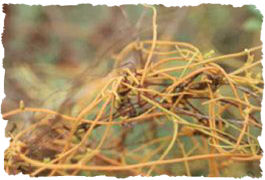 |
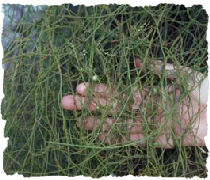 |
Veminium A bluish wildflower commonly found on the lower ranges of the Thentis mountains, also referred to as the Thentis Veminium; used in perfumes. The Desert Veminium is a small and purplish flower found in the Tahari; also used in perfumes.
"The atmosphere of the pool was further charged with the fragrance of Veminium, a kind of bluish wild flower commonly found on the lower slopes of the Thentis range; the walls, the columns, even the bottom of the pool, were decorated with representations of Veminium, and many of the plants themselves were found in the chamber." — Assassin of Gor, pages 163-164.
"I smelled veminium oil. The petals of veminium, the 'Desert Veminium,' purplish, as opposed to the 'Thentis Veminium,' bluish, which flower grows at the edge of the Tahari, gathered in shallow baskets and carried to a still, are boiled in water. The vapor which boils off, is condensed into oil. This oil is used to perfume water. This water is not drunk but is used in middle and upper-class homes to rinse the eating hand, before and after the evening meal. — Tribesmen of Gor, pages 50-51.
Verr Grass Grass found in the Tahari; a staple for the verr of the desert nomads. It is described in all quotes as "brownish", however, it is most likely not naturally a brown grass, it browns as any other grass does when dying in the heat of too much sun and no water.
The beast had been taken southeast of Ar, while moving southeast. Such a path would take it below the eastern foothills of the Voltai and to the south. It was incredible. "Who would enter such a place?" asked Samos.
"Caravans, crossing it," I said. "Nomads, grazing their verr on the stubble of verr grass." — Tribesmen of Gor, page 27."On the shaded sides of some rocks, and the shaded slopes of hills, here and there, grew stubborn, brownish patches of verr grass." — Tribesmen of Gor, page 72.
"Standing afoot, in the dust, with his lance, the nomad watched us turn away. Behind him was a herd of eleven verr, browsing on brownish snatches of verr grass. He would have defended the small animals with his life. Their milk and wool was his livelihood, and that of his family." — Tribesmen of Gor, page 167.
Vines A plant whose stem requires support and which climbs by tendrils or twining or creeps along the ground.
"Without thinking, I leaped from the back of Nar, seizing one of the long, tendril-like vines that parasitically interlace the gnarled forms of the swamp trees." — Tarnsman of Gor, page 85.
Violet Grass Patches of stalky grass, one of several hues used in pleasure gardens of Turia.
"He picked up a stalk of a patch of violet grass, one of several hues used in such gardens, and began to chew on it." — Nomads of Gor, pages 216-217.
Vosk Rushes Rushes found in the marshes of the Vosk delta. See: "Rushes."
"I took the triangular-bladed tem-wood paddle and moved the small craft, light and narrow, large enough scarcely for one man, ahead. It was formed of pliant, tubular, lengthy Vosk rushes, bound with marsh vine." — Raiders of Gor, page 1.
![]()
Special Note
Because of the differences in publishing the books, depending upon whether published in the U.S. or Europe, depending upon whether a first publishing or a Masquerade Books release, page numbers will often vary. All of my quotes are from original, first-printing U.S. publications (see The Books page for a listing of publishers and dates) with the exception of the following books:
- Tarnsman of Gor (2nd Printing, Balantine)
- Outlaw of Gor (11th Printing, Balantine)
- Priest-Kings of Gor (2nd Printing, Balantine)
- Assassin of Gor (10th Printing, Balantine)
- Raiders of Gor (15th Printing, Balantine)
- Captive of Gor (3rd Printing, Balantine)
Disclaimer
These pages are not written for any specific home, but rather as informational pages for those not able to get ahold of the books and read them yourself. Opinions and commentaries are strictly my own personal views, therefore, if you don't like what you are reading — then don't. The information in these pages is realistic to what is found within the books. Many sites have added information, assuming the existences of certain products and practices, such as willowbark and agrimony for healing, and travel to earth and back for the collection of goods. I've explored the books, the flora, the fauna, and the beasts, and have compiled from those mentioned, the probabilities of certain practices, and what vegetation mentioned in the books is suitable for healing purposes, as well as given practicalities to other sorts of roleplaying assumptions.
